8th Special Operations Squadron
(1974-Present) |
Acknowledgment: Thanks to John D. Lock, Lt.Col, USA (Ret) and author, for his permission to use his article on Operation Eagle Claw.
Thanks to the Special Operations Warrior Foundation for permission to use their materials about Desert One (Colonel Carney’s article and the AF Magazine articles). Thanks to Tracey White of the Spec War Net for use of the materials dealing with Operation Eagle Claw. Our appreciation for the materials in the Northwest Florida Daily News; USAF Military Fact Sheets; Special Operations.com: 8th SOS; FAS.org; Global Security.org;Skytamer.com; and Crestview Chamber of Commerce webpages. Lastly we are deeply indebted to the historical information found at Air Force Historical Research Agency (AFHRA) on line. 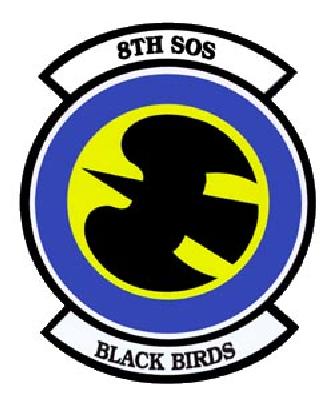 On a Yellow disc within a Blue band, On a Yellow disc within a Blue band,
edged with a narrow White border, a stylized climbing bird,
which is entirely Black.
MOTTO: BLACK BIRDS.
Approved on 19 Jul 1993
8th Special Operations Squadron: By the end of 1975, the entire Air Force SOF capability had been cut to one undermanned wing (the 1st SOW) at Hurlburt Field, Florida, with three squadrons assigned (the 8th, 16th, and 20th SOSs), and two Talon squadrons stationed
overseas (the 1st and 7th SOSs). Barely 3,000 personnel remained in SOF during the late 1970s.
16th Special Operations Wing The following excerpted from 16th SOW. "The 16th Special Operations Wing consists of approximately 7,000 highly trained military professionals who stand ready to conduct special operations missions at a moment's notice. The wing is the largest Air Force unit assigned to the U.S. Special Operations Command, a command responsible for conducting special operations worldwide."
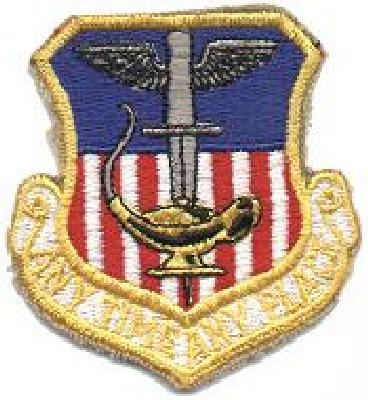
16th SOW
MOTTO: Any time, Any place"The 16 SOW specializes in unconventional warfare. At the direction of the National Command Authorities, the 16 SOW goes into action with specially trained and equipped forces from each service working as a team to support national security objectives. Special operations are often undertaken in enemy-controlled or politically-sensitive areas and can cover a myriad of activities."
"The 16 SOW's motto is, "Any Time, Any Place." The wing stands ready to go worldwide to conduct unconventional warfare, counterinsurgency, or psychological operations. Through special operations, the United States is able to protect its interests in low-intensity conflicts throughout the world."
16th SOW Consolidates with 919th SOW (Reserve) In 1998, the 919th was divided into two associate units at two locations - Duke Field and Eglin AFB. The 5th SOS was grafted into the active duty's 9th Special Operations Squadron at Eglin AFB as an associate unit. This placed all MC-130P Combat Shadow aircraft in the entire Air Force inventory under the control of the active duty's 16th Special Operations Wing.
Following that transition, all MC-130E Combat Talon I aircraft were placed in the Air Force Reserve at Duke Field. As a result, the 711th SOS became the only active associate unit in the Air Force. In February 2000, the active duty 8th Special Operations and the 716th Maintenance Squadron moved from Hurlburt Field to Duke Field to share the Combat Talon mission with the 919th SOW. This makes the 919th SOW the only reserve unit in the Air Force with active duty people assigned to it. The 919th SOW received its 10th Outstanding Unit Award as a result of the successful transition to active associate units.
The Wing employs approximately 1300 reservists and 300 federal civil service employees to meet its mission requirements. The following appeared in Oct 2002 issue of the Air Force Reserve Magazine, Citizen Airmen: Oct 2002 Smooth TransitionSpecial operations unit blends forces, sustains readiness
Pamela S. Nault
Callused hands covered with grease and grime that are seemingly permanently embedded beneath fingernails. Skin roughened and irritated through use of harsh industrial-strength cleaners. Knuckles that never seem to heal from repeated blows against engine components while manipulating wrenches in tight places. Such is the life of a turboprop jet engine mechanic. Such is the daily routine of Senior Airman Sean Preston.
"Our hands really take a beating," said the 21-year-old aerospace propulsion apprentice assigned to the 919th Maintenance Squadron, a subordinate unit of the Air Force Reserve's 919th Special Operations Wing at Duke Field, Fla. "It goes with the territory of maintaining the MC-130 (Combat Talon I). It's what we do here, and it's especially important as we fight the war on terrorism."
In Total Force tradition, Preston, a reservist, works shoulder to shoulder with Airman First Class Shaun Gamble, a 19-year-old propulsion mechanic assigned to the 716th MXS, a subordinate unit of the active duty's 16th SOW at Hurlburt Field, Fla.
"It's like we're joining hands, rough hands, to accomplish the mission," Preston said.
Although the partnering of reservists and active-duty members is routine in today's Air Force, the situation surrounding Preston and Gamble's working relationship represents a unique and historic melding of special operations forces.
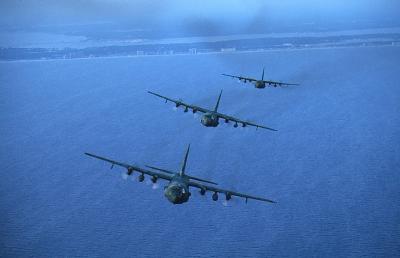
16th SOW MC-130s in formationAbout 2 1/2 years ago, officials at Headquarters Air Force Special Operations Command, Hurlburt Field, and HQ Air Force Reserve Command, Robins Air Force Base, Ga., decided that consolidating special operations assets into two associate organizations would better integrate the forces, improve operations and save money, all without having a detrimental effect on the mission.
"With limited resources, it just made sense to combine four special operations flying squadrons, and corresponding maintenance squadrons, that operate the same weapons systems," said Col David C. Peel, chief of programs in HQ AFRC's Directorate of Plans and Programs. With 22 years of experience in special operations, Peel was part of the transition team that implemented the consolidation at Duke. "There have been a few growing pains along the way, but overall it's been a smooth transition."
In a traditional associate unit setup, the Reserve's 5th Special Operations Squadron, which belongs to the 919th SOW, joined forces with the active duty's 9th SOS at Eglin AFB, Fla. Crews and maintainers from the two units work in unison to meet mission requirements in MC-130P Combat Shadow aircraft, which are now owned by the 16th SOW. With the move, the 5th SOS transferred ownership of its five aircraft to the active duty.
The Combat Shadow's primary mission is to fly clandestine or low-visibility missions into politically sensitive or hostile territory to provide air refueling for special operations helicopters. The aircraft's secondary mission is to airdrop leaflets, small special operations teams and equipment.
What makes the arrangement between AFSOC and AFRC unique is the second associate unit formed by the two commands. In this arrangement, the Reserve's 919th SOW assumed ownership of the Air Force's inventory of 14 Combat Talon I aircraft and shares flying and maintenance responsibilities with the active duty's 8th SOS and 716th MXS. Approximately 300 active-duty people now report to Duke Field to do their jobs each day.
The Combat Talon I is capable of delivering people and equipment, either from the air or on the ground, deep into hostile territory during day or night, even under adverse weather conditions. In addition, the aircraft has an aerial refueling capability for special operations helicopters.
"It's working well," said Brig. Gen. Mark Stogsdill, 919th SOW commander, referring to the associate unit arrangement. "It's a more efficient way of doing business."
In the aftermath of the attacks on America's homeland Sept. 11, 2001, special operations forces from the various military services have been heavily involved in America's aggressive war on global terrorism.
"We're tested with each mission we conduct in support of Operation Enduring Freedom, and we haven't missed a (scheduled) sortie," Stogsdill said. "Our perfect combat mission effectiveness record with 100 percent maintenance mission efficiency says it all about our flyers and maintainers."
The general said his unit was fortunate to be able to use several previously established Reserve associate programs as a guide for the Combat Shadow consolidation. In addition, he said, getting the first and only active associate unit off the ground and running at its current high level of efficiency demonstrated the great teamwork between the 919th and 16th SOW.
"Working together with the active duty is something we've done for years, and it was just a matter of enhancing those relationships with an innovative idea and stepping into new territory with this blend of forces," said Stogsdill, a master navigator with more than 6,500 flying hours, including 450 combat hours in AC-130 Spectre gunships. "What we did here may serve as a role model for other weapons systems to follow."
"We in the 16th SOW are honored to fight side by side with the men and women of the 919th SOW," said Col. Lyle Koenig, 16th SOW commander. "There's no question we can't do our mission without them, and we look forward to our continued partnership."
Among the expected benefits of the consolidation was cost savings. Active-duty and Reserve officials agree that the relationship is saving money, but defining the savings in specific terms is a challenge, said Bascom R. Grant Jr., 919th SOW financial analysis officer.
"There are so many variables that come into play that it's difficult to give a firm cost-savings number," Grant said. "The benefit of streamlining the weapons systems in one place, coupled with integrated training, is not necessarily measured in dollars. The active associate wing eliminated approximately 30 percent of the active-duty operators and maintainers."
Grant said reducing the work force while maintaining the same number of flying hours produces a substantial savings.
Preston and Gamble, who each have worked on both the Combat Shadow and Combat Talon aircraft, said the consolidation benefits maintenance workers.
"Previously, I'd work on the Shadow one day and the Talon the next," Gamble said. "The consolidation made work easier because of the consistency of working on one aircraft on a regular basis."
In February, President George W. Bush paid a visit to Eglin AFB to honor the "quiet professionals," as special operations people are known. During his visit, Bush thanked the commanders for their leadership, praised the war-fighting capability of special operations forces in Afghanistan, and announced a $48 billion budget proposal to fund the war on terrorism, homeland security and a pay raise for military members.
"Our military has a new mission for the 21st century," the president said. "It came suddenly, but you were ready. You destroyed Afghan terrorist training camps and freed a country from brutal oppression."
Addressing the men and women in uniform, Bush said, "You perform with daring and dedication. You've made an impression on the enemy. You've given the terrorists around the world their first glimpse at their fate."
"We were especially honored when President Bush visited Eglin Air Force Base and specifically commented on our Total Force," Koenig said.
Preston was one of more than 8,000 military people and family members who turned out to welcome the president.
"It was a once-in-a-lifetime opportunity to see in person the president of the United States," said Preston, a native of Panama City, Florida. "He made it very clear that the war on terrorism is a priority. His positive comments about the military made me proud to wear the uniform."
Since October 2001, several hundred reservists from the 919th SOW have been serving on active duty in support of Operation Enduring Freedom. Gamble said the 12-hour shifts that are necessary to keep up with the war's demands are challenging, but morale among the people is very high.
"We do what's expected of us and then do even more," said the Gastonia, N.C., native.
Preston, a part-time student, said the increased duty hours forced him to more closely manage his time to keep up with his studies. His goal is to obtain a nursing degree, compliments of the GI Bill, and apply for a commission.
"I'd like to complete my military service as an aeromedical flight nurse," he said. "No more grease and grime."
Meanwhile, the associate unit transition continues to be a work in progress. All of the major work, such as modifications to buildings, new construction, and the movement of aircraft, equipment and personnel, is complete. Now it's a matter of working out the smaller details and fine-tuning the processes, Stogsdill said.
"A team effort made our conversion to two associate units a success, while maintaining our combat capability to effectively conduct the war on terrorism," he said. "That speaks highly of the talented men and women in special operations. I'm proud to serve with them and to be a part of this historic associate unit transition."
(Ms. Nault is chief of the Community Relations/Environmental Division in the AFRC Office of Public Affairs at Robins AFB.)
8th Special Operations Squadron The 8th Fighter Squadron reverted to its old name the 8th Special Operations Squadron on 1 Mar 1974 when it was assigned to Eglin Air Force Auxiliary Field No. 9 (Hurlburt Field) FL. Hurlburt Field is in the Fort Walton Beach area.
It was first assigned to the 1st Special Operations (later, 834th Tactical Composite; 1st Special Operations) Wing on 1 Jul 1974. It was later assigned to the 1st Special Operations (later 16th Operations) Group on 22 Sep 1992.
It transitioned to the MC-130 "Combat Talon I". The squadron absorbed the personnel and equipment (Lockheed MC-130E Combat Talon I) of the inactivated 318th Special Operations Squadron.
On 20 June 1975, the 8th SOS absorbed the assets of the 415th Special Operations Training Squadron gaining the Lockheed AC-130A and AC-130H gunships. Later that year these assets were transferred to the 919th Special Operations Group and the 16th Special Operations Squadrons, respectively.
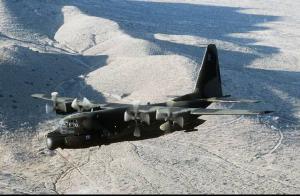
Talon I flying near Yuma, AZ, early 80s (John Franklin)The first of the MC-130H, Combat Talon IIs, arrived on 17 October 1991 and later that year the squadron was split into two sections (Talon I and Talon II). The lineal descendant of this proud squadron is the famed 8th Special Operations Squadron ("Blackbirds") of Hurlburt Field, Florida flying MC-130E Combat Talon I aircraft as part of the 16th Special Operations Wing. The 8th Special Operations Squadron is currently the second longest continuously operational active duty squadron in the U.S. Air Force since its inception in 1917. The primary mission of the 8th SOS is insertion, extraction and re-supply of un-conventional warfare forces and equipment into hostile or enemy-controlled territory using airland or airdrop procedures. Numerous secondary missions include psychological operations, aerial reconnaissance and helicopter air refueling.
To accomplish these varied missions, the 8th SOS uses the Combat Talon I, a highly specialized variant of the Lockheed C-130. The history of the Talon I stretches back to 1966 when the first C-130E was modified and a small squadron established at Pope Air Force Base, N.C. Later that year four of these specially modified MC-130s were deployed to Nha Trang, Republic of Vietnam, in support of the war in Southeast Asia.
During the Southeast Asia conflict, Combat Talon Is were extensively involved in covert/clandestine operations in Laos and North Vietnam. They routinely flew unarmed, single-ship missions deep into North Vietnam under the cover of darkness to carry out unconventional warfare missions in support of Military Assistance Command's Special Operations Group.  On a Yellow disc within a Blue band, On a Yellow disc within a Blue band,
edged with a narrow White border, a stylized climbing bird,
which is entirely Black.
MOTTO: BLACK BIRDS.
Approved on 19 Jul 1993In early spring 2000, the 8th SOS transfered to Duke Field with its Combat Talon I aircraft. Duke Field (or Eglin Air Force Base Auxiliary Field 3, Florida) is six miles south of Crestview. The unit combined its forces with the 711th SOS, which also flies the Combat Talon I aircraft.
Under the associate unit concept, an active-duty unit owns the aircraft and Reserve crews and maintainers augment the missions. In this case, however, the Air Force Reserve will own all the Combat Talon I aircraft as both units form an associate unit flying the Combat Talon I aircraft.
As of Feb 2000, they have become the Air Force's only active-duty associate unit serving with the Air Force Reserve Command's 919th Special Operations Wing. The move is part of an overall plan for Air Force Special Operations Command to combine Reserve and active-duty components onto common airframes. These changes result from mission changes, adjustments for efficiency, congressional directives and implementation of the expeditionary aerospace force concept.
Their mission includes: supporting unconventional warfare missions and special operations forces. The MC-130 aircrews work closely with Army Special Forces and Navy SEALs (sea-air-land teams). In addition, the 8th is able to conduct psychological warfare operations by air dropping leaflets and can drop the world's largest conventional bomb, the 15,000 pound BLU-82, for special attack or psychological effect. The following is from Special Operations.com: 8th SOS: The primary mission of the 8th SOS is insertion, extraction and re-supply of un-conventional warfare forces and equipment into hostile or enemy-controlled territory using airland or airdrop procedures. Numerous secondary missions include psychological operations, aerial reconnaissance and helicopter air refueling. To accomplish these varied missions, the 8th SOS uses the Combat Talon I, a highly specialized variant of the Lockheed C-130. The history of the Talon I stretches back to 1966 when the first C-130E was modified and a small squadron established at Pope Air Force Base, N.C. Later that year four of these specially modified MC-130s were deployed to Nha Trang, Republic of Vietnam, in support of the war in Southeast Asia. During the Southeast Asia conflict, Combat Talon Is were extensively involved in covert/clandestine operations in Laos and North Vietnam. They routinely flew unarmed, single-ship missions deep into North Vietnam under the cover of darkness to carry out unconventional warfare missions in support of Military Assistance Command's Special Operations Group.
Since its initial development, major modifications have been made to the Combat Talon I to ensure its continued viability through technological superiority. Today's Combat Talon I with its state-of-the-art computer systems is capable of terrain following operations as low as 250 feet in all weather conditions. Crews from the 8th SOS can drop equipment or personnel on small, unmarked drop zones with pinpoint accuracy, day or night. Additionally, the Talon I gives the squadron a truly global reach with the ability to receive gas from Air Force tanker aircraft and transfer gas to special operations helicopters. The Talon I is equipped with an electronic warfare package to counter the threat of detection by enemy radar by deceiving or jamming many types of enemy radar. The aircraft also employs infrared jamming pods, chaff, and flares to combat the threat of enemy missiles. These updates ensure the Combat Talon I will remain a weapon of choice into the 21st Century. Combat Talon I forces have been tasked on numerous occasions to use their unique capabilities in the interest of national objectives. In 1970, Combat Talon Is led assault forces on the North Vietnamese Son Tay prisoner of war camp. During the raid they also functioned as an airborne jammer and command post, providing vectoring information for mission aircraft.
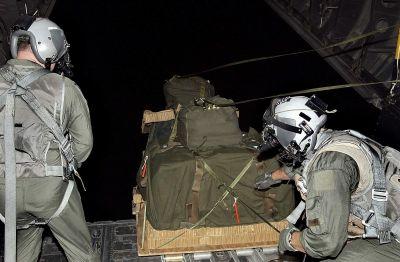
| NELLIS AIR FORCE BASE, Nev. (AFIE) -- Staff Sgts. Clay Johns and Tommy Mazzone, loadmasters from the 8th Special Operations Squadron at Hurlburt Field, Fla., release a palette during an airdrop mission during Millennium Challenge 2002 on July 29. (U.S. Air Force photo by Staff Sgt. Aaron D. Allmon II) (VIRIN: 020729-F-7823A-012) |
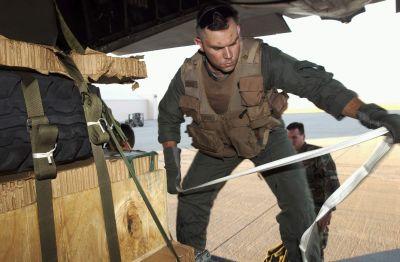
| NELLIS AIR FORCE BASE, Nev. (AFIE) -- Tech. Sgt. Tommy Mazzone, a loadmaster from the 8th Special Operations Squadron at Hurlburt Field, Fla., loads a palette aboard a MC-130E Combat Talon on July 29 for an air drop during Millennium Challenge 2002. MCO2 is the premier joint warfighting experiment, bringing together live field forces and computer simulation and runs July 24 to Aug. 15. (U.S. Air Force photo by Staff Sgt. Aaron D. Allmon II) (VIRIN: 020729-F-7823A-010) |

| NELLIS AIR FORCE BASE, Nev. (AFIE) -- Staff Sgt. Clay Johns, a loadmaster from the 8th Special Operations Squadron at Hurlburt Field, Fla., peers out of a MC-130E Combat Talon window before an airdrop during Millennium Challenge 2002 on July 29. MC02 combines live field forces and computer simulations at several locations across the United States with the purpose of testing and validating several joint and service-specific experimental warfighting concepts. (U.S. Air Force photo by Staff Sgt. Aaron D. Allmon II) (VIRIN: 020729-F-7823A-008) |
Move to Duke Field A relay of unit members carried the guidon of the 8th Special Operations Squadron 26 miles from their old home at Hurlburt Field, Fla., to their new home at Duke Field, Fla., on 5 Feb 2000. The 8th SOS is now the Air Force's only active duty associate unit. The Reserve owns the field's six Combat Talon I aircraft, while the 8th SOS provides aircrews and maintainers who share flying time and upkeep on the airplanes. The following is excerpted from and Special Operations.com:
In early spring 2000, the 8th SOS transfered to Duke Field with its Combat Talon I aircraft. The unit will combine its forces with the 711th SOS, which also flies the Combat Talon I aircraft.
Under the associate unit concept, an active-duty unit owns the aircraft and Reserve crews and maintainers augment the missions. In this case, however, the Air Force Reserve will own all the Combat Talon I aircraft as both units form an associate unit flying the Combat Talon I aircraft.
The move is part of an overall plan for Air Force Special Operations Command to combine Reserve and active-duty components onto common airframes. These changes result from mission changes, adjustments for efficiency, congressional directives and implementation of the expeditionary aerospace force concept. The following is an AFRC News Service from a 919th SOW news release (Release No. 00018 - 02/09/00). Squadrons relocate, become active-duty associate unitsDUKE FIELD, Fla. - Cheers from onlookers rang out as members of the 8th Special Operations Squadron trotted onto the flag-lined street of their new home Feb. 5.
After 26 years at Hurlburt Field, Fla., six MC-130E Combat Talon I aircraft along with aircrews and maintainers transferred 26 miles away to Duke Field to serve with Air Force Reserve Command’s 919th Special Operations Wing.
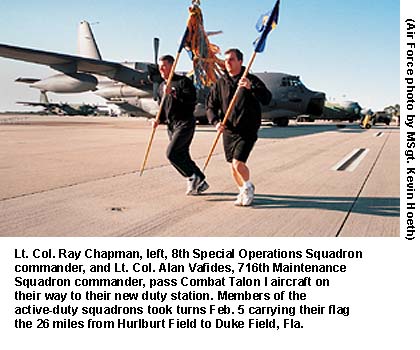
The active force’s 8th SOS departed its Hurlburt home in gala fanfare, with members of the squadron forming a relay to carry the unit guidon from Hurlburt to Duke Field. The move began a new chapter in Air Force history as the squadron became the Air Force’s only active-duty associate unit. A small ceremony after the run signified the birth of the active associate unit. Another active-duty unit, the 716th Maintenance Squadron, “stood up” at Duke Field as part of the active-duty associate unit.
In an active-duty associate unit, the Reserve owns the aircraft and the active force provides aircrews and maintainers who share their mission of flying and maintaining aircraft.
Although the 8th SOS and 716th MXS work at Duke Field on Reserve aircraft, they remain part of the 16th SOW, headquartered at Hurlburt. Approximately 300 active-duty members will be integrated into the flying and maintenance units at Duke with the Reserve wing.
The 919th SOW originally owned eight Combat Talon I’s flown by the 711th SOS. Now all 14 Combat Talon I aircraft are at Duke Field. The move is part of an overall plan for Air Force Special Operations Command to combine Reserve and active-duty components onto common airframes.
Col. David J. Scott, 16th SOW commander, explains that there a bit of sadness with the 8th SOS leaving Hurlburt. "The 8th SOS and the maintainers who keep the MC-130E’s flying have the richest heritage in the wing. We'll feel loss when the Talon I’s depart their Hurlburt Field home. That being said, uniting the Talon community at Duke will join our active-duty force with the veterans now serving with the Reserve. That’s a good thing."
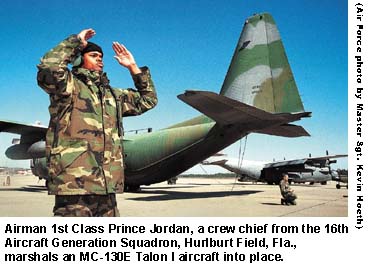
Scott added that a larger, combined force operating from one base will be stronger and more versatile than two smaller ones separated by 26 miles.
"Working together with the active duty is something we’ve done for years, and we look forward to having them here at Duke Field," said Col. Mark Stogsdill, 919th SOW commander. "It’s an innovative idea, and we’re going into new territory with this blend of forces."
The transfer of the Talon I’s to Duke Field is the 919th SOW’s second reorganization in the past six months. The wing’s other flying squadron, the 5th SOS, which flies MC-130P Combat Shadows, formed up with its active-duty counterpart at Eglin AFB, 17 miles south of Duke.
In October, the 919th SOW gave up all five of its Combat Shadow aircraft at Duke and transferred its Combat Shadow squadron and maintenance workers. The squadron became a Reserve associate unit with the active force’s 9th SOS. Under the Reserve associate unit concept, an active-duty unit owns the aircraft and Reserve crews and maintainers augment the missions. There are several Reserve associate units throughout the Air Force, mostly in Air Mobility Command as well as Air Combat Command and Air Education and Training Command.
MC-130P Combat Shadows and MC-130E Combat Talon I aircraft have similar missions, but the Combat Talon I’s have more instruments designed for covert operations. Both aircraft fly infiltration/exfiltration missions - airdrop or land personnel and equipment in hostile territory. They also air refuel special operations helicopters and usually fly missions at night with aircrews using night-vision goggles. The Combat Talon I, however, has an electronic countermeasures suite and terrain-following radar that enables it to fly extremely low, counter enemy radar and penetrate deep into hostile territory.
The 919th SOW is the only Air Force Special Operations Command-gained unit in the Reserve and has some 1,200 reservists assigned. Approximately 300 full-time civilian/reservists are employed at Duke Field.
711th Special Operations Squadron According to Global Security.org, "The 711th SOS has 8 of the Air Force's inventory of 14 MC-130E Combat Talon I aircraft assigned to it. It transitioned to that aircraft from the AC-130A Spectre gunship beginning in September 1995. The mission called on the squadron to perform specialized day or night low-level delivery of troops or cargo into denied or hostile areas."
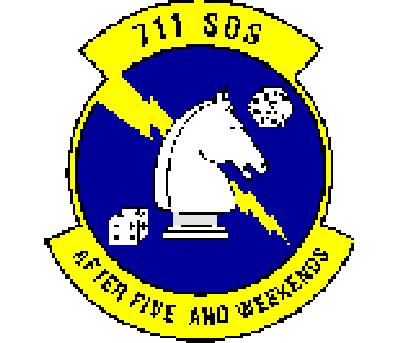 In early spring 2000, the 8th SOS transferred to Duke Field with its Combat Talon I aircraft and combined its assets with the 711th SOS under the associate unit concept. In this concept, an active-duty unit owns the aircraft and Reserve crews and maintainers augment the missions. However, in this case, the Air Force Reserve will own all the Combat Talon I aircraft as both units form an associate unit flying the Combat Talon I aircraft.
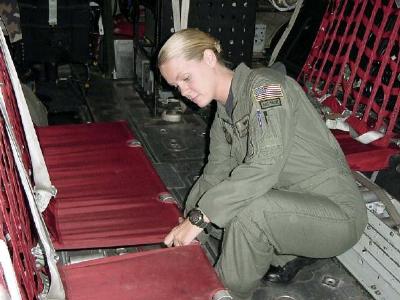
711th SOS Loadmaster on Talon I MC-130E."The move is part of an overall plan for Air Force Special Operations Command to combine Reserve and active-duty components onto common airframes. These changes result from mission changes, adjustments for efficiency, congressional directives and implementation of the expeditionary aerospace force concept."
Duke Field The following is from the Crest View Chamber of Commerce: DUKE FIELD
919th Special Operations Wing
The 919th Special Operations Wing is the only Air Force Reserve unit in Air Force Special Operations Command. In serveral ways, the 919th SOW is unique in the way it is organized. The Wing's two flying units, the 5th Special Operations Squadron, and the 711th Special Operations Squadron, fly two types of aircraft and operate from two locations inthe area. Additionally, units are divided into two different types of associate units.
The 711th SOS is an associate unit and is the only one of its type in the Air Force--called an active associate unit. The difference is that the Air Force Reserve owns the aircraft and the active duty provides the crews and maintenance personnel to share the mission. Recently, the Air Force transferred all 14 Combat Talon I aircraft to the Air Force Reserve with the 919th SOW. The 711th SOS, which flies MC-130E Combat Talon I aircraft, shares its mission of flying and maintaining the aircraft with the active duty's 8th Special Operations Squadron and the 716th Maintenance Squadron. The 919th SOW maintains operational control of the Combat Talon Is;the 8th SOS and 716th MXS report to the 16th Special Operations Wing at Hurlburt Field, Florida.
The 919th SOW's other flying squadron, the 5th SOS, is part of the traditional associate unit where the active duty owns the aircraft and reserve forces augment the mission. The 5th SOS is located at Eglin AFB, Florida, 17 miles south of Duke Field. Together with the 719th Maintenance Det 1, the 5th SOS shares the mission of flying and maintaining MC-130P Combat Shadow aircraft with the active duty's 9th SOS and 16th Maintenance Squadron. Approximately 150 reservists and 45 full-time civil service work in the 5th SOS and Maintenance Detachment 1. The 9th SOS and 16th MXS are part of the 16th Special Operations Wing.
The main part of the 919th SOW is located at Eglin Air Force Base Auxiliary Field 3, Florida (Duke Field) six miles south of Crestview. The 919th SOW employs more than 1,200 reservists and 300 full-time civil service employees. The Combat Talon I aircraft are located at Duke Field. The wing's payroll is more than $28 million annually, and the wing generates an estimated $53 million yearly in the Northwest Florida panhandle. 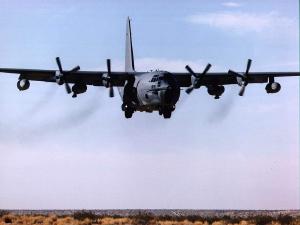
64-0566 MC-130 Combat Talon I inflight, presently with 711th SOS
(Bart Jingst )
Operations of the 8th SOS:- Operation Eagle Claw: Iranian Hostage Rescue Mission (April 1980): On November 4, 1979 a mob in Iran stormed the US Embassy and took the staff and USMC security contigent hostage. In all, 52 Americans were captured and were being held by the Iranian Revolutionary Guard and it was unclear whether they were being tortured or readied for execution. Within hours, the newly certified US Army Special Forces Operational Detachment-Delta (Airborne) was on full alert and plans were being hastily drawn up for a rescue. Unfortunately, the plans went awry and soon turned into disaster.
The following was excerpted from an article by John D. Lock, former ranger and author, at Operation Eagle Claw. Despite the tragic accident that aborted the mission, the bravery of the men involved in this operation is unquestioned and needs to be retold.
To Fight with Intrepidity: Operation Eagle Claw
Denigrating the U.S. as the "Great Satan," a mob of militant followers of the Ayatollah Khomeini stormed the American Embassy in Tehran on 4 November 1979 and took sixty-six Americans hostage. Finally, it was determined that it was a matter of national honor as well as moral and political obligation to conduct a military operation to rescue the remaining fifty-three captives. The mission went to Colonel Charlie A. Beckwith. A veteran of Korea and Vietnam, "Chargin' Charlie" was a hardened Green Beret and Ranger who was considered to be the premier U.S. expert in unconventional warfare.
Colonel Beckwith was commander of 1st Special Forces Operational Detachment-Delta (1SFOD-D) more commonly referred to as "Delta Force," a secret...at the time...elite team of commandos who were specifically trained in a number of antiterrorist tasks, one of which was to surreptitiously infiltrate target areas dressed in civilian clothes and free hostages from buildings.
On 11 April 1980, President Carter authorized the rescue mission to be conducted thirteen days later, on the 24th. The mission called for a group of 130 Delta, Rangers, drivers, and translators to be inserted into the Iranian desert by a support force of fifty pilots and air crewmen. Six C-130 Hercules transports were to lift the men, their equipment, and helicopter aviation fuel from the Egyptian air base at Qena to the island airfield of Masirah off the coast of Oman for a refueling stop.
From there, the force would fly to a secret landing strip in Iran, designated "Desert One." Located 265 nautical miles from the hostages held in Tehran, this site would be secured by the Rangers. Eight Sea Stallion RH-53D helicopters launched from the aircraft carrier U.S.S. Nimitz on station in the Arabian Sea would join them.
Refueled at Desert One by C-130s carrying fuel bladders, the helicopters would depart prior to dawn to transport the assault force of 120 men to a remote mountain hideaway designated "Desert Two" located fifty miles from Tehran. After their departure, the remaining Ranger security element and aircraft would sterilize and depart Desert One and return to Qena.
Later that evening, the commandos would clandestinely depart Desert Two and drive in vans and trucks to Tehran to storm the American Embassy compound at around 2300 to free the hostages. Approximately forty minutes after the assault commenced, the helicopters would arrive from their hide site, about fifteen miles from Desert Two, to load the freed hostages and the commando force either in the vicinity of the embassy compound or a nearby soccer stadium.
Two AC-130H Spectre gunships would be on station overhead to interdict any Iranian mobs on the ground and to prevent any Iranian Air Force aircraft from taking off at a nearby airfield.
As the assault was commencing by the Delta team at the embassy compound, eighty Rangers would be airlifted from Qena to an isolated desert airstrip at Manzariyeh. Located thirty-five miles south of Tehran, this airstrip was part of an unoccupied former bombing range and had an asphalt paved runway that would be secured by the Rangers and used by C-141 Starlifters. Withdrawing from the embassy compound to the airstrip by helicopter, the Delta commandos and hostages would load the Starlifters. Then they, along with the helicopter crews, drivers, translators, and DOD agents...select individuals who were operating in Tehran in support of the rescue attempt...would depart for Qena, mission complete.
Once the other elements were lifted out, the Rangers would collapse their perimeter and fly out themselves. Delayed demolition charges would ensure the destruction of the helicopters left behind.
At least, that's how the plan was to work in theory. After a couple of false starts, the mission was launched from the United States on 20 April. On 24 April, the majority of the ground force, to include a detail of Rangers from C Company, 1st Battalion, 75th Rangers, boarded two C-141s and flew to Masirah Island. Later that evening, they departed for Desert One.
At 1930 on the deck of the aircraft carrier U.S.S. Nimitz, eight Sea Stallions crewed by Marines rose in formation and began their fateful six-hundred-mile flight to Desert One under radio listening silence. Maintenance problems caused one helicopter to be abandoned along the way and a second to abort and return to the Nimitz. The mission was now down to the minimum number of helicopters Beckwith thought necessary to accomplish the mission.
At Desert One, Rangers deployed to establish security and a road watch while Delta support personnel prepared to receive the soon to be arriving helicopters. The Ranger road watch team had no sooner off-loaded a jeep and spread out when a large Mercedes bus drove up to the field. Stopping only after shots were fired over the bus, the forty-five distressed Iranians were unloaded from the bus and secured.
Minutes later, another approaching vehicle was spotted, a small fuel truck. Failing to halt, the vehicle was set afire by an antitank rocket fired by a Ranger. Quickly exiting the burning truck, the driver ran a hundred yards back to a pickup that had moved into the perimeter undetected. In a blaze of rubber and tossed sand, the pickup with its two passengers escaped in a hail of bullets.
The last two helicopters arrived at Desert One, nearly an hour and a half late. But, with their arrival, the mission's fate had been sealed, for one of the last two aircraft had sustained a crippling mechanical malfunction. With the mission now down to only five operational helicopters, the mission was aborted.
The task then at hand was to close up Desert One and get everyone safely back to Egypt. At approximately 0200, while maneuvering to top off with fuel from a C-130, a Helo pilot became disoriented in the great swirls of dust created by his engine and that of the C-130. Moving left, then right, the helicopter banked and crashed into the refueling C-130, creating a mammoth fireball in the desert night that caused fuel and debris to rain all about.
From the side troop doors of the stricken C-130, thirty-nine soldiers tumbled or were carried out while other soldiers risked their lives to rescue several unconscious men trapped on the ground near the raging inferno. The five Air Force crewmen in the C-130 cockpit as well as three Marines in the helicopter perished in the intense flames. Four Army soldiers suffered serious burns.
All helicopters were immediately abandoned and for the entire force of Delta, Rangers, and support personnel to load on the remaining C-130s. Equipment was jettisoned from the C-130s to make room for the extra bodies that had not been originally planned on the manifest. Left behind at Desert One were five serviceable helicopters, weapons, communications equipment, secret documents and maps...as well as fifty-three hostages in Tehran, a nation's honor, and its pride.
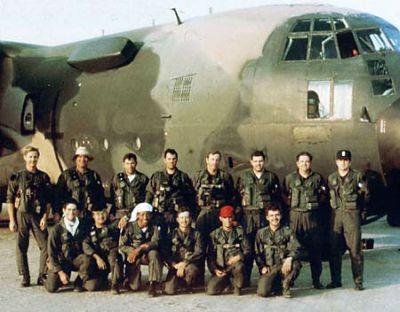
| The crew involved in the Air Force's failed April 25, 1980 attempt to rescue 52 American hostages from the U.S. embassy in Tehran pose in front of their C-130 transport on April 24, 1980, in the Oman desert. The following day, the aircraft was involved in a crash with a Marine Corps helicopter. Top Row (from left): Maj. Richard Bakke, killed; unidentified survivor; Tech Sgt. Joel Mayo, killed; Lyn McIntosh, killed; Maj. Harold Lewis Jr., killed; Capt. Charles McMillan, killed; Staff Sgt. J.J. Beyers, survivor; Col. Jeff Harrison, survivor. Bottom Row: unidentified survivors. (The Associated Press) |
For personal accounts of the survivors, go to Airman Magazine: April 2001, "Desert One" and Airman Magazine: May 2001, "A Night to Remember".
According to Skunk Works Digest "Lockheed C-141B Starlifter of the 437th MAW, MAC, based at Charleston AFB, MS, to extract the Delta Forces and hostages from Manzariyey, two equipped as "hospitals" (one as spare) and one as "airliner". Instead both specially equipped medevac aircraft flown to Masirah, Oman, to evacuate the wounded to Wadi Kena, Egypt, after the aborted mission."
According to an article on Spec War Net: Operation Eagleclaw: What was ultimately decided on was an audacious plan involving all four services, eight helicopters (USMC RH-53's), 12 planes (four MC-130's, three EC-130's, three AC-130's, and two C-141's), and numerous operators infiltrated into Tehran ahead of the actual assault. The basic plan was to infiltrate the operators into the country the night before the assault and get them to Tehran, and after the assault, bring them home.
The first night, three MC-130's were to fly to an barren spot in Iran and offload the Delta force men, Combat Controllers, and translators/truck drivers. Three EC-130's following the Combat Talon's would then land and prepare to refuel the Marine RH-53's flying in from the US Carrier Nimitz. Once the helicopters were refuled, they would fly the task force to a spot near the outskirts of Tehran and meet up with agents already in-country who would lead the operators to a safe house to await the assault the next night. The helicopters would fly to another site in-country and hide until called by the Delta operators.
On the second night, the MC-130's and EC-130's would again fly into the country, this time with 100 Rangers, and head for Manzariyeh Airfield. The Rangers were to assault the field and hold it so that the two C-141's could land to ferry the hostages back home. The three AC-130's would be used to provide cover for the rangers at Manzariyeh, support Delta's assault, and to supress any attempts at action by the Iranian Air Force from nearby Mehrabad Airbase. Delta would assault the embassy and free the hostages, then rendevous with the helicopters in a nearby football stadium. They and the hostages would be flown to Manzariyeh Airfield and the waiting C-141's and then flown out of the country. All the aircraft but the eight helicopters would be flown back, the helicopters would be destroyed before leaving.
What actually happened was far different from what was planned.
A month before the assault a CIA Twin Otter had flown into the first landing area, known as Desert One. A USAF Combat Controller had rode around the landing area on a light dirt bike and planted landing lights to help guide the force in. That insertion went well, with no contact, and the pilots reported that their sensors had picked up some radar signals at 3,000 feet but nothing below that.
Despite these findings, the helicopter pilots were told to fly at or below 200 feet to avoid radar. This limitation caused them to run into a haboob, or dust storm, that they could not fly over without breaking the 200 foot limit. Two helicopters lost sight of the task force and landed, out of action. Another had landed earlier when a warning light had come on. Their crew had been picked up but the aircraft that had stopped to retrieve them was now 20 minutes behind the rest of the formation.
Battling dust storms and heavy winds, the RH-53's continued to make their way to Desert One. After recieving word that the EC-130's and fuel had arrived, the two aircraft that had landed earlier started up again and resumed their flight to the rendevous. But then another helicopter had a malfunction and the pilot and Marine commander decided to turn back, halfway to the site. The task force was down to six helicopters, the bare minimum needed to pull off the rescue.
The first group of three helicopters arrived at Desert One an hour late, with the rest appearing 15 minutes later. The rescue attempt was dealt it's final blow when it was learned that one of the aircraft had lost its primary hydralic system and was unsafe to use fully loaded for the assault. Only five aircraft were servicable and six needed, so the mission was aborted.
Things got worse, though, when one of the helicopters moved to another position and drifted into one of the parked EC-130's (in the pilot's defense, it was dark and his rotors kicked up an immense dust cloud, making it difficult to see). Immediately both the C-130 and RH-53 burst into flames, lighting up the dark desert night. The C-130 was evacuated and the order came to blow the aircraft and exfiltrate the country.
However, in the dust and confusion the order never reached the people who would blow the aircraft. There were wounded and dying men to be taken care of and the aircraft had to be moved to avoid having the burning debris start another fire. Because of this failure to destroy the helicopters, top secret plans fell into the hands of the Iranians the next day and the agents waiting in-country to help the Delta operators were almost captured.
The Aftermath: broken aircraft at Desert One. All told, five Air Force personnel and three Marines lost thier lives and dozens more were injured. The Iranians scattered the hostages around the country afterwards, making any further rescue attempts impossible. They would be released later, after ??? days of imprisonment.
Lessons LearnedInsufficient information and bad planning played a key role in the failure of the rescue. The planners had calculated that it would take the eight RC-53's four hours and twenty minutes to make the flight; it had taken five hours twenty minutes. The Air Weather Service had not been able to predict the low level dust storms that hampered the mission. If they had, some more low-level bad weather flight training might have made the flight easier and have prevented the fatal crash that killed eight people.
Also, the helicopter crews had been thrown together at the last minute after it was discovered that many of the Marine pilots lacked the skills necessary to complete the mission. It was a combination of Air Force, Navy, and Marine pilots who flew the mission. In one case, unfamiliarity with the aircraft caused one pilot to ground the aircraft when it could have flown the mission. Also see Bibliography of Operation Eagleclaw for more sources of information.
8th SOS Aircraft of Operation Eagle Claw The final operation plan - Operation 'Eagle Claw' - involved staging three MC-130 command and communication transport aircraft (including an MC-130E-Y, 64-0565, and an MC-130E-C, 64-0572, of the 8th Special Operations Squadron) together with three EC-130Hs equipped as tankers with wing probes (62-1809, 62-1818 and 62-1857 of the 7th Airborne Command and Control Squadron) to Masirah Island; all these aircraft were upgraded to include T56A-15 engines. Meanwhile USS Nimitz would sail into the Gulf of Oman with eight RH-53D Sea Stallion helicopters of Navy Helicopter Mine Countermeasures Squadron HM-16 embarked from USS Kitty Hawk (CVA-63), as the C-141 Starlifters and a C-9 Nightingale transport carrying a hospital and burns unit deployed to Eqypt. A message in Skunk Works Digest from Kathryn & Andreas Gehrs-Pahl on 17 Mar 1997 lists all the Eagle Claw aircraft on supply and tanker missions for deployment to and from Wadi Kena, Egypt.
- 1 Lockheed MC-130E Hercules, COMBAT TALON I, Special Operations aircraft of the 8th SOS 'Black Birds', 1st SOW, TAC, based at Hurlburt Field, FL, used as spare and later returned to Wadi Kena, Egypt, and supposed to be used in Night Two operations (?).
- * 3 Lockheed EC-130H ABCCC aircraft of the 7th ACCS, 552nd AWACW, TAC, based at Keesler AFB, MS, but flown by pilots of the 8th SOS 'Black Birds', 1st SOW, TAC, based at Hurlburt Field, FL. Used as fuel transporter and ground refueller for the RH-53Ds at Desert-I. Selected mainly because they had in-flight refueling capability. Type Call Sign Serial Pilot ------ *
- MC-130E DRAGON-1 ..-.... Capt. Bob Meller flew 1 hour ahead, surveyed and secured the Desert-I landing site, and returned back to Oman after the EC-130Hs arrived; *
- MC-130E DRAGON-2 ..-.... Capt. Marty Jubelt brought felta Force and other personnel to the landing site, and returned back to Oman after the EC-130Hs arrived; *
- MC-130E DRAGON-3 ..-.... Capt. Steve Flemming brought Delta Force and other personnel as well as a SATCOM radio to the landing site, and returned after the accident with helicopter crews and other personnel after REPUBLIC-5 left; *
- Based at Wadi Kena, Egypt: - -------------------------- * 4 Lockheed MC-130E Hercules, COMBAT TALON I, Special Operations aircraft, of the 8th SOS 'Black Birds', 1st SOW, TAC, based at Hurlburt Field, FL, to be used to transport Rangers to the airport at Manzariyey. *
The Guts to Try The following is an Associated Press article on 15 April 2000. 'The guts to try' still inspires 20 years after failed rescue mission
By BILL KACZOR
Associated Press
HURLBURT FIELD -- After the fiery collision of a helicopter and transport plane killed eight servicemen in an Iranian desert, survivors of their ill-fated mission got an unusual message that still inspires 20 years later.
British workers at an airfield on an island off Oman wondered why only five U.S. Air Force C-130s returned on April 25, 1980 after six of the four-engine turboprops had taken off the night before.
They soon realized what happened to the missing plane after hearing news reports of a failed attempt to rescue 52 American hostages from the U.S. embassy in Tehran, recalled retired Col. Roland Guidry, then commander of the 8th Special Operations Squadron.
''They got two cases of cold beer and put them in a jeep and ran them around the edge of the runway to our tent city,'' Guidry said. ''One of them had written on the top case of beer an inscription that said, 'To you all from us all for having the guts to try.' ''
The message was torn off and taken back to Hurlburt where it was framed and put in the squadron's trophy room.
''The Guts to Try'' became the motto of a mission that may have failed but also prompted a buildup of special forces -- focusing on clandestine operations, guerrilla tactics and counter-terrorism -- which later paid off with successes in Grenada, Panama, Iraq and the Balkans.
Improvements were made in aircraft, training, communications, interservice coordination, command structure and tactics. The changes were qualitative and quantitative, said Col. Kenneth Poole, 48, of Anniston, Ala., a navigator aboard one of the surviving C-130s in Iran.
''If I need four airplanes to do an operation I'm going to send six,'' said Poole, now chief of contingency operations for the Air Force Special Operations Command at Hurlburt. ''That's called Iran math.''
Guidry was aboard the lead plane in Iran and then participated in the buildup as chief of air operations for the U.S. Special Operations Command, which was created at Fort Bragg, N.C., as a result of the disaster. The joint command is now at MacDill Air Force Base near Tampa.
''Although I hated to lose five people under my command, we're probably much better off in special operations today, 20 years later, because this mission failed,'' said Guidry, now a real estate broker in nearby Destin. ''It was a wake-up call.''
Five Hurlburt airmen and three Marines died when a Marine helicopter that was trying to take off crashed into a C-130 parked at Desert One, their rendezvous point.
The mission's 20th anniversary will be marked with a memorial service and symposium Thursday at Hurlburt. A ceremony sponsored by the humanitarian group No Greater Love is set for April 25 at Arlington National Cemetery.
The rescue attempt was an audacious plan, code named Eagle Claw, that nearly worked, Guidry said.
Six C-130s landed at Desert One with an Army Delta Force and fuel for eight Navy and Marine Corps helicopters from the aircraft carrier USS Nimitz.
The choppers then were to take the attackers to a hideout near Tehran. The next night, trucks purchased by operatives in Iran, would have taken them to the embassy. Another assault force aboard C-130s would fly to and capture an Iranian airfield.
The helicopters would pick up everyone from the embassy and fly them to the airfield where transport planes would take them out of Iran.
The mission never got that far. One helicopter, struggling to find its way through engine-clogging dust kicked up by a sand storm, turned back. A second was forced down by mechanical problems and another chopper picked up its crew.
One of the helicopters that made it to Desert One also was out of commission, leaving only five. At least six were needed to go on so the mission was aborted.
There were other problems. A bus came by on a dirt road shortly after the lead C-130 landed. Its driver and about 40 passengers were held until the Americans left.
Then a gasoline tanker truck drove up and a soldier, ordered to stop it, blew it up with a rocket, said Chief Master Sgt. Taco Sanchez, of Murray, Ky., then a loadmaster on the lead plane.
''When you look back on it 20 years later it is kind of comical in a way, but at that time it was bloody-ass scary,'' said Sanchez, 46, Hurlburt's top-ranking noncommissioned officer.
It got worse. The helicopters were refueled to fly back to the carrier, but when one lifted off it became engulfed in dust, clipped a C-130's tail and spun into the transport's cockpit area.
''The whole windscreen lit up,'' said retired Staff Sgt. J.J. Beyers, the C-130's radio operator. ''We thought we were being shelled.''
Beyers, 57, of nearby Niceville, tried to go down steps to the cargo bay when something hit him and he blacked out. He came to in the cargo bay and crawled to a door. ''As I got there I stood up and a couple of Delta boys came and got me out,'' he recalled.
Of seven men on the flight deck, only Beyers and a relief pilot standing beside him survived. Three other airmen and dozens of assault troops made it out of the cargo bay.
Retired Air Force Col. John Carney, 59, of Tampa, was a combat air traffic controller watching from 100 yards away as munitions exploded, flames shot from the wreckage and a plume of black smoke billowed into the night sky.
''It was just a scene right out of 'Apocalypse Now,' '' he said.
Bodies were trapped in the burning wreckage and had to be left behind. Iran gave the remains to Swiss officials who turned them over to the United States.
Beyers was the most seriously injured survivor with lung damage and severe burns to his hands. He is permanently disabled and medically retired.
To provide for the education of 15 children left behind by the eight men who died, their comrades created the Special Operations Warrior Foundation. Two of Beyers' six children also were given scholarships.
Carney, the foundation's president, said it has since raised $1 million and provided grants to 347 more children of lost special operations personnel.
The military trained for a second rescue, but it was never attempted. Iran released the hostages after 444 days of captivity in January 1981 as Ronald Reagan was sworn in as president.
The C-130 crews straggled back to Hurlburt with their ''guts to try'' memento instead of the hostages they hoped to rescue.
''It was the right thing to do,'' Sanchez said. ''Did we do it? No. But I can tell you that if we had the same mission today we'd prosecute it 100 percent and we'd bring 'em home.''
Honoring the Heroes of Operation Eagle Claw The following was extracted from the Air Force Magazine: April 2001Remembering heroes
April 2001
Eight men died during the aborted attempt to rescue American hostages held captive in Iran. Five of them were airmen from the 8th Special Operations Squadron at Hurlburt Field, Fla. Three were Marine helicopter crewmen.
“Take solace in the fact [that] what they did only a few could even attempt,” said Lt. Gen. Norton Schwartz, the commander of Alaskan Command, at a 20th anniversary commemorative ceremony at Hurlburt Field, Fla. “What they did was keep the promise. They had the guts to try.”
Schwartz was a pilot in the 8th SOS at the time of the rescue mission and went on to command Hurlburt’s 16th Special Operations Wing.
Another special operator and now chairman of the Joint Chiefs of Staff, Gen. Hugh Shelton, expressed similar sentiments during a speech at an April 2000 ceremony at Arlington National Cemetery honoring those killed.
“The sheer audacity of the mission, the enormity of the task, the political situation at the time. When I reflect on the results — both positive and negative — I’m awed,” Shelton said.
“The very soul of any nation is its heroes. We are in the company of giants and in the shadow of eight true heroes,” he said.
Those heroes are Capt. Richard L. Bakke, 33; Capt. Harold J. Lewis, 35; Capt. Lyn D. McIntosh, 33; Capt. James T. McMillan II, 28; Tech. Sgt. Joel C. Mayo, 34; Marine Staff Sgt. Dewey L. Johnson, 31; Marine Sgt. John D. Harvey, 21; and Marine Cpl. George N. Holmes Jr., 22. — Master Sgt. Jim Greeley
As a footnote, on December 19, 2001 the U.S. House of Representatives has passed a bill naming a new Post Office in Valdosta for Air Force Major Lyn David McIntosh, who lost his life during a mission in 1979 to rescue 66 Americans held hostage at the U.S. Embassy in Iran. President Bush signed it into law.
Operation Urgent Fury Combat, Grenada (24 Oct–3 Nov 1983): The squadron was called on again in October 1983 to lead the way in the rescue of American students endangered on the island of Grenada. After long hours of flight, the aircrew members faced intense ground fire to airdrop Army Rangers on time, on target. They subsequently followed up with three psychological operations leaflet drops designed to encourage the Cubans to discontinue the conflict.
The Rangers had little time to prepare for their role in Urgent Fury. Within hours of receiving orders to move, Ranger units were marshaling at Hunter Army Airfield, Georgia, prepared to board C-130s and MC-130s for the ride to Grenada.
The invasion in the south focused on an unfinished runway at Point Salines, located on the island's most southwestern point. While securing the airfield, Rangers were to secure the True Blue Campus at Salines, where American medical students were in residence. As quickly as possible, Ranger units were then to take the army camp at Calivigny. A Navy SEAL team which was to have provided intelligence on the airfield at Salines was unable to get ashore. At 0534 the first Rangers began dropping at Salines from 8th SOS MC-130E and other C-130s, and less than two hours elapsed from the first drop until the last unit was on the ground, shortly after seven in the morning. After the rangers had secured the runway, 800 more troops would land, freeing the rangers to press northward where they were to secure the safety of American medical students and bring under control the capital of St. Georges. At the end of the first day in Grenada, the Rangers had secured the airfield and True Blue Campus at a cost of five dead and six wounded. Once the Rangers had secured the runway, elements of the 82nd Airborne Division landed, and late in the evening of the 26th the 82d Division's 3d Brigade began to deploy across the island. In the north, 400 Marines would land and rescue the small airport at Pearls.
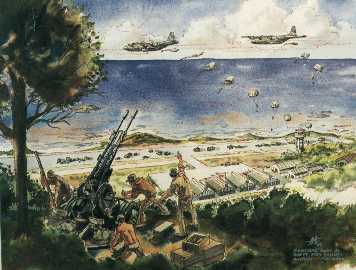
Painting of MC-130E Ranger air drops
According to Operation Urgent Fury, "The 8th Special Operations Squadron ... was called on again in October 1983 to lead the way in the rescue of American students endangered on the island of Grenada. After long hours of flight, the aircrew members faced intense ground fire to airdrop U.S. Army Rangers to Point Salinas Airfield in the opening moments of Operation Urgent Fury. They subsequently followed up with three psychological operations leaflet drops designed to encourage the Cubans to discontinue the conflict."
It continued, "In regard to PSYOP in Grenada, Stanley Sandler says in Cease Resistance: It's Good for You: A history of U.S. Army Combat Psychological Operations, 1999. "4th PSYOP Group loudspeaker teams attached to the 82nd Airborne Division, in addition to persuading significant numbers of frightened Peoples Revolutionary Army (PRA) troops to turn themselves in, confirmed the enemy's low morale as well as the desire of even some of the Cuban "Construction Battalions" to remain on the island with their Grenadian wives and families."
Regarding leaflets, Sandler says, "But other, more specialized leaflets, emphasized that this was a combined operation with other Caribbean nations as well as the United States acting against a foreign threat. Something new was added when U.S. PSYOP troops photographed captured Grenadian Communist leaders in captivity, thus reassuring citizens that they could now go about their business unmolested by a cabal whom most genuinely feared. One such leaflet, headlined "These hoodlums are now in custody," displayed most unflattering photos of the subjects while another showed the two chiefs of the Marxist clique, Bernard Coard and Hudson Austin, in safe custody on a U.S. Navy ship with the message "Former PRA members: Your corrupt leaders have surrendered. Knowing resistance is useless...Join your countrymen now in rebuilding a truly democratic Grenada."
Sandler says in an article printed in Mindbenders, Vol. 9, No.3, 1995: "The 4th PSYOP Group distributed leaflets giving the Grenadian population guidance and information, and a newly-deployed 50-kilowatt transmitter, "Spice Island Radio," broadcast news and entertainment throughout the island.
Radio Free Grenada was one of the first targets of American bombs. To replace Radio Free Grenada, the U.S. set up Spice Island Radio, under the overall control of the Psychological Operations Section of the Army. A twelve-man team of Navy journalists immediately flew in from Norfolk, recruited some local announcers, and Spice Island Radio was on the air. Their first broadcast called on Grenadians to lay down their arms. The head of the Navy team, Lt. Richard Ezzel, told Reuters, "We wanted to save lives."
Department of the Army FM 33-1, Psychological Operations, July 1987, mentions the Grenada PSYOP campaign. "The 1983 Grenada operation included PSYOP elements from all the services. These elements provided the commander with the primary means of mass communication with both the enemy and local populace. The communication capability was especially important during the initial phases of the operation.
Leaflets directing the populace to remain indoors and tune their radios to a specific frequency were designed by the Army and printed aboard Navy ships. Other leaflets, produced both at Ft. Bragg and on the island, were effectively used during the consolidation operations to encourage Grenadian civilians to report information concerning Peoples Revolutionary Army (PRA) and Cuban soldiers. An Air Force airborne transmitter station was used by PSYOP elements to broadcast information after the Grenada radio station was rendered inoperative during the first day of operation. By the third day, a small land-based PSYOP station commenced operations. Later, Army PSYOP elements deployed a large 50KW transmitter capable of broadcasting to the entire island. Eventually, PSYOP personnel were broadcasting 11 hours per day."
For more details on the Operation go to FAS: Operation Urgent Fury
Operation Just Cause Panama (20 Dec 1989–14 Jan 1990): Members of the 8th SOS were mobilized in December 1989 as part of a joint task force for Operation Just Cause in the Republic of Panama. 3 MC-130Es from the 8th SOS Black Birds were part of the US flying units of Operation "Just Cause" SOCOM ("Joint Task Force South") under the 23rd Air Force. From late December 1989 to early January 1990, 23 AF participated in the re- establishment of democracy in the Republic of Panama during Operation JUST CAUSE. Special operations aircraft included active and AFRES AC-130 Spectre gunships, EC-130 Volant Solo psychological operations aircraft from the ANG, HC-130P/N Combat Shadow tankers, MC-130E Combat Talons, and MH-53J Pave Low and MH-60G Pave Hawk helicopters. Special tactics combat controllers and medics provided important support to combat units during this operation. Spectre gunship crews of the 1 SOW earned the Mackay Trophy and Tunner Award for their efforts, a 919 SOG Spectre crew earned the President’s Award, and a 1 SOW Combat Talon crew belonging to the 8th SOS ferried the captured Panamanian President, Manuel Noreiga, to prison in the United States. Likewise, the efforts of the 1 SOW maintenance people earned them the Daedalian Award.
According acig.org The attack was initiated by two F-117As, which around 23:00hrs local time dropped two GBU-24s in front of Noriegas HQ at Rio Hato. This operation later caused much discussions, as it was declared for a failure by the public, while the bombs fell right where they were expected to do as the intention was for them to create confusion. Nevertheless, instead of creating confusion, the bombs alerted the Panamese, and when the 13 C-130s loaded with troops of the TF „Red“ arrived over Rio Hato they were confronted by the fire from several ZPU-4 heavy machine guns, caliber 14.7mm. Before the two escorting AC-130s could intervene, the 8th SOS MC-130E that lead the formation of Hercules‘ was obviously hit by ground fire and forced to make an emergency landing with only three engines in working order. The Gunships – soon after jointed by two AC-130As each from the 711th and 919th SOS AFRes, which took off from Howard AFB – then started suppressing the air defenses and this made it possible for the Hercules transports to disgorge rangers from a level of only 600ft/200m. Due to a number of heavily-loaded troopers landing on the concrete runway, 35 of them were injured, but in general they managed to swiftly recover and attack the main terminal of Rio Hato, which was secured by 0153hrs of 20 December. Shortly after the first transports started landing there, bringing reinforcements and evacuating casualties. During this attack the rangers lost two killed and 27 injured (in addition to 35 troops injured during the landing), while the PDF lost 34 killed and 260 captured. The TF „Red“ – now supported by several AH-64As and AH-6s flown in from Howard AFB, and the two 711th SOS AC-130As – then started preparing for its next task. The following was excerpted from and adds to the confusion....a flight of darkened MC-130 Combat Talons and C-130E Hercules STOL turboprop aircraft approach at 500 feet... standing in the door are sticks of U.S. Army Rangers stooped over rucksacks so heavy, it takes both hands to lift and drag them to the jump doors....The Rangers are so encumbered by equipment that they cannot even stand up straight. Approaching their dark target, the GREEN LIGHT COMES ON, through the open jump doors they see red and green tracer fire below. The Rangers strain out the jump doors, some without reserve parachutes: a towed jumper caught by this overload of equipment on the edge of the jump door could get dragged through the air---- if cut away falls to his death....if pulled in, he may be a bloody pulp as he bangs against the side of the aircraft if those still inside wait until everyone jumps; if pulled in early, he blocks the door so Rangers cannot join the battle below to help win it.
A C-130E Hercules pilot writes:
"I saw your web page as a link from the 75th Ranger Reg't page. I flew in Panama, dropping Rangers in Rio Hato, point of fact, we were a 17 ship formation of C-130Es, there were no MC-130s in the airdrop at Rio Hato. When we left from Ft Benning or Panama, the weather was crap and we were overloaded to the point had we lost one engine we would likely have become a smokin' hole. We weighed less than the maximum published wartime weight, but that weight is based on sea-level standard day (59 degrees F) takeoff. When it's cold, that's usually better unless you have to steal engine power to keep the ice off the wings." 
General NoriegaOn 3 January 1990, the majority of the force redeployed, but a small element remained behind. During the evening of 3 January, two MH-60s from the 160th transported General Noriega from the Papal Nuncio to Howard AFB for transload to a waiting MC-130 and transport to the United States.
Operation Desert Shield (August 1990-Jan 1991) Operation Desert Shield commenced in August 1990 when Iraq invaded Kuwait. The 8th SOS was deployed to Saudi Arabia as a deterrent against the Iraqi threat to its southern neighbor.
Operation Desert Storm, Southwest Asia, (16 Jan-17 Mar 1991) In January 1991, when Iraq failed to comply with United Nations directives to withdraw from Kuwait, the proven skills of the 8th SOS were called on once again as Desert Shield escalated into Desert Storm. The 8th SOS played a pivotal role in the success of coalition forces as they liberated Kuwait by dropping eleven 15,000 pound BLU-82 bombs and 23 million leaflets and conducting numerous aerial refuelings of special operations helicopters.
Its primary mission was Psyops operations. One third of all airdrops in the first three weeks of Desert Storm were flown by Talons.
The Talons can also be rigged to let loose one of the Air Force's largest bombs, the BLU-82, roughly the size of a Volkswagen Beetle and weighing about 15,000 pounds, or to release propaganda and warning leaflets.
Its secondary mission was search and rescue behind the lines. The Talons can be used to refuel the Pave Lows and other helicopters or sneak behind enemy lines to deliver ground forces, vehicles and supplies.

During the Vietnam War, the USAF used 10,000-lb. M121 bombs left over from World War II, to blast Helicopter Landing Zones (HLZ) in the dense undergrowth. As the supply of M121 bombs dwindled, the USAF developed the Bomb Live Unit-82/B (BLU-82/B) as a replacement. Weighing a total of 15,000 lbs., the BLU-82/B was essentially a large thin-walled tank (1/4-inch steel plate) filled with a 12,600-lb. explosive "slurry" mixture. The designers optimized this bomb to clear vegetation while creating little or no crater, and it cleared landing zones about 260 feet in diameter-just right for helicopter operations. Since only cargo aircraft could carry them, C-130 crews delivered the BLU-82/B with normal parachute cargo extraction systems. The BLU-82/B first saw use in Vietnam on March 23, 1970. Throughout the rest of the war, the USAF used them for tactical airlift operations called "Commando Vault." After the war, the BLU-82/B was used during the Mayaguez rescue in May 1975, but the remaining BLU-82/Bs went into storage until the mid-1980s, when the Air Force Special Operations Command began using them again in support of special operations. During Operation Desert Storm, MC-130E "Combat Talon" aircraft from the 8th Special Operations Squadron dropped 11 BLU-82/Bs, primarily for psychological effects. The USAF used these weapons against terrorist strongholds in Afghanistan during Operation Enduring Freedom. (WPAFB USAF Museum)
(SITE NOTE: In March 2003, the 21,000lb superbomb was announced. It is an upgrade of the BLU-82. It contains 21,000lb of conventional high explosive, an increase from the 15,000lb BLU-82 "daisy cutter" used at least four times on tunnels and caves in Afghanistan. The warhead is packed with Gelled Slurry Explosive, which is detonated with a high explosive booster. The slurry is poured into the bomb's casing which is then loaded on to a plane and launched by parachute at 6,000ft. There is not yet much public information available about the MOAB (Massive Ordnance Air Burst). It weighs 21,500 pounds, compared to the 15,000 pound Daisy Cutter, and is the size of a small truck. Like the Daisy Cutter, the MOAB is designed to be dropped out of the back of a C-130 aircraft, but can possibly be dropped from a C-17 aircraft, as well. Unlike the Daisy Cutter, which is a free-fall (dumb) bomb, that descends attached to a parachute, the MOAB is a precision bomb guided by GPS (Global Position Satellite). After being pulled out of the cargo hold of the aircraft by a parachute, the parachute releases, and the GPS guides the bomb to the target destination. At a designated altitude, the MOAB sprays the area with a highly flammable mist, which is then ignited by a conventional explosive within the bomb. The results are a truly devastating explosion that can destroy tanks, buildings, and personnel in an area of several hundreds of meters.) (See C-130 Bombers for BLU-82 in Vietnam.) |
Extracted from Source: Unknown The men of the Eighth Squadron believed that the BLU-82 bomb could send an even more powerful message. In the early-morning hours of Feb. 7, Maj. Charles Bingington's MC-130E Combat Talon cargo plane lumbered off the runway. In its belly sat the massive bomb. Behind Major Bingington, a companion plane lifted off, carrying another BLU-82 (Bingington and his wingman became known as the Blues Brothers).
The day before, their target area had been rained with leaflets warning the soldiers below: "Tomorrow if you don't surrender we're going to drop on you the largest conventional weapon in the world." The Iraqis who dared to sleep that night found out the allies weren't kidding. The explosion of a Daisy Cutter looks like an atomic bomb detonating. In the southwest corner of Kuwait that night, an enormous mushroom cloud flared into the dark. Sound travels for miles in the barren desert, and soon Iraqi radio nets along the border crackled with traffic. Col. Mike Samuel, Schwarzkopf's special-operations commander, cabled a message back to the U.S. Special Operations Command headquarters in Florida: "We're not too sure how you say 'Jesus Christ' in Iraqi." A British SAS commando team on a secret reconnaissance mission near the explosion frantically radioed back to its headquarters: "Sir, the blokes have just nuked Kuwait!"
The next day a Combat Talon swept over the bomb site for another leaflet drop with a follow-up message: "You have just been hit with the largest conventional bomb in the world. More are on the way." The victims below didn't need much more convincing. The day after the BLU-82 attack, an Iraqi battalion commander and his staff raced across the border to surrender. Among the defectors was the commander's intelligence officer, clutching maps of the minefields along the Kuwait border. The intelligence bonanza enabled Central Command officers to pick out the gaps and weak spots in the mine defenses. When the ground war began Marine and allied forces breached them within hours.
The bombs cost about $27,000 each. They are dropped from a C-130 cargo plane flying at least 6,000 feet off the ground, to avoid the bomb's massive shock wave. Each is more than 17 feet long and 5 feet in diameter - about the size of a Volkswagen Beetle but far heavier. The MC-130s dropped the BLU-82s again to breach holes in the minefields around Kuwait prior to the assault.
Operation Restore Hope, Somalia (9 Dec 1992 - 4 May 1993) ???? 16th SOW involved, extent unknown. Uncertain if 8th SOS MC-130E/H involved. Operation Restore Hope in Somalia proved to be one of the most diverse humanitarian operations undertaken by US military forces; it quickly highlighted the need for better interagency coordination. President Bush Sr. authorized the operations. In Somalia the military was challenged to coordinate the activities of "49 different UN and humanitarian relief agencies--none of which were obligated to follow military directives." By March 1993, mass starvation had been overcome, and security was much improved. At its peak, almost 30,000 US military personnel participated in the operation, along with 10,000 personnel from twenty-four other states. Despite the absence of political agreement among the rival forces, periodic provocations, and occasional military responses by UNITAF, the coalition retained its impartiality and avoided open combat with Somali factions. However, once President Clinton was inaugurated he stated his desire to scale down the U.S. presence in Somalia, and to let the U.N. forces take over. In March 1993 the U.N. officially took over the operation, naming this mission UNOSOM – II. This precipitated the turmoil to follow. For the military action in the Battle of Mogadishu, go to FAS: Restore Hope for details.
Operation Provide Promise, Bosnia (3 July 1992-9 January 1996) According to Special Operations.com, "The U. S. Air Force relies on the proven abilities of the 8th SOS as evidenced by its recent deployments in support of Operations Provide Promise and Deny Flight in Bosnia."
Provide Promise, which had begun on 3 July 1992, was the international response to an ethnic civil war in Bosnia-Herzegovina in which efforts by Muslims and Croats to secede from Yugoslavia and establish an independent Bosnia were violently resisted by Bosnian Serbs--clandestinely aided by Yugoslavia--who attempted to establish a Serbian republic of Bosnia.
(NOTE: Still researching this item. (Source: FAS: 8th SOS.) Uncertain of MC-130 involvement -- perhaps as Psyops. Possible OPERATION ALLIED FORCE when an MC-130 supported the rescue operation for the downed F-117A pilot.)
Operation Deny Flight, Bosnia (12 April 1993 - 21 December 1995) According to Special Operations.com, "The U. S. Air Force relies on the proven abilities of the 8th SOS as evidenced by its recent deployments in support of Operations Provide Promise and Deny Flight in Bosnia." (Additional Source: FAS: 8th SOS.)
Deny Flight enforced the no-fly zone, provided close air support to UN troops, and conducted approved air strikes under a "dual-key" command arrangement with the UN. NATO Airborne Early Warning and Control (AWACS) aircraft began monitoring operations in October 1992, in support of UN Security Council Resolution 781, which established a no-fly zone over Bosnia-Herzegovina. Data on possible violations of the no-fly zone has been passed to the appropriate UN authorities on a regular basis.
NATO's Deny Flight operation, enforcing the no-fly zone over Bosnia, terminated on December 20, 1995, when implementation force (IFOR) assumed responsibility for airspace over Bosnia. Operation Deny Flight transitioned to Decisive Endeavor/Edge in support of the IFOR Operation Joint Endeavor.
(NOTE: Still researching this entry. Records of U.S. aircraft indicates only 3 x USAF EC-130 Airborne Battlefield Command and Control Center aircraft at Aviano AB, Italy; 2 x USAF EC-130 electronic warfare aircraft at Aviano AB, Italy; 2 x USAF AC-130 Gunship aircraft at Brindisi AB, Italy. No mention of 8th SOS MC-130s. (Source: AF South Fact Sheet.))
Operation Assured Response, Liberia (9 April - 18 June 1996) According to Special Operations.com, the 8th SOS was deployed on Operation Assured Response. In 1996, the US Military assisted in safeguarding and evacuating Americans from Liberia when that nation's civil war reignited into factional fighting and general violence in Liberia." During the first week of April 1996, as a result of intense street fighting during the ongoing civil war in Liberia, about 500 people sought refuge on American Embassy grounds and another 20,000 in a nearby American housing area. On April 6, the president approved the US ambassador's request for security, resupply and evacuation support.
Air Force special operations forces led the evacuation effort, Operation Assured Response. Air Force KC-135 tankers and C-130 transports were put on alert in Europe to support 24-hour operations, while other mobility aircraft began to deliver critical medical supplies, food, water, fuel and communications gear. On April 9, less than 72 hours after the decision to deploy U.S. forces, the first MH-53 helicopter landed in Monrovia to begin the operation. Those evacuated continued on US helicopters through Freetown, Sierra Leone, then on MC-130s to Dakar, Senegal, all under the cover of AC-130 gun ships. Throughout the rest of the week, the evacuation continued, as well as airlift of critical supplies to sustain the effort. By April 14, the evacuation was essentially complete, however, security and sustainment operations continued through Aug. 3. In this operation, Air Force special operations forces safely evacuated over 2,400 civilians representing 68 countries. (For further information, see Global Security: Operation Assured Response.)
Operation Enduring Freedom, Afghanistan (2001-On-going): According to Global Security.Org: Enduring Freedom Order of Battle, the 8th Operations Squadron was part of the Joint Special Operations Aviation Component South, 8th Special Operations Squadron, MC-130E, Masirah AB, Oman with 539 personnel. However, the specifics of the 8th SOS missions are unknown at this time. (For more information on Operation Enduring Freedom, go to Global Security.Org: Enduring Freedom.)
According to Lessons Learned:
TYPE MISSIONS: INFIL / EXFIL, RESUPPLY, AIRDROP,
AIRLAND, BLU-82, HAR, PSYOP,
HUMANITARIAN RELIEF
SORTIES FLOWN:- MC-130E 1,718
- MC-130H 1,106
HOURS FLOWN:- MC-130E 4,351
- MC-130H 5,172
Fight against international terrorism continues world-wide. Specific missions unknown at this time, but possible events as follows. According to Afghanistan Casualty Report, :
- An MC-130 medevaced some wounded from a forward deployed location during Operation Anaconda. (March 2002)
- C-130s dropped four BLU-82 bombs in Afghanistan.
- A USAF MC-130H of the 16th Special Operations Wing crashed on take-off in Afghanistan on June 12, 2002. There were three fatalities. SFC Peter P. Tycz II (USA), TSgt Sean M. Corlew (USAF), and SSgt Anissa A. Shero (USAF).
In October 2001, video of an operation to Kandahar taken by military camera operators and released by the Pentagon showed dozens of Rangers packing their gear inside at a large aircraft hangar, loading onto a heavily armed MC-130E Combat Talon cargo plane, then parachuting onto the airfield. A separate video showed other commandos on the ground at the command center, collecting rocket-propelled grenades, a machine gun and ammunition. Some explosions could be seen on the grainy, greenish video. The following is from The Observer on October 21, 2001: US special forces kill 20 in fierce Afghan firefight Jason Burke, Peshawar, Ed Vulliamy, New York and Kamal Ahmed, London
Sunday October 21, 2001
The Observer
American special forces were yesterday involved in pitched battles inside Afghanistan after being parachuted into an area where Osama bin Laden, the prime suspect in the 11 September terrorist attacks, has been a frequent visitor.
More than 100 US commandos and light infantry Rangers fought with Taliban forces near the regime's spiritual stronghold of Kandahar, the Taliban's spiritual centre - where bin Laden has been a frequent visitor - and a military airport 60 miles to the southeast. Some 20 Taliban soldiers were reportedly killed. US helicopters were seen over Kandahar again last night, apparently confirming reports of further attacks.
The forces siezed intelligence from a complex which serves as one of the Taliban command and control compounds which they hope will reveal clues to the whereabouts of the Taliban leader Mullah Mohammed Omar and bin Laden. After a savage 30-minute firefight, US troops also cleared the airstrip building by building.
'We have accomplished our objective at the airfield,' said General Richard Myers, chair of the Joint Chiefs of Staff, last night. 'We did not expect to find significant Taliban leadership at these locations,' he said. 'We, of course, were hoping we would, but we did not expect it, and we did not find senior Taliban of Al-Qaeda leadership.'
Other operations involving ground troops were imminent, he added. 'We are going to have ongoing operations around the world.'
The general revealed that the US commandos came across stores of rocket propelled grenades, machine guns and ammunition and destroyed them.
In Britain, Ministry of Defence sources said detachments of British Royal Marines could shortly be sent to the region. In the event of a long ground war, Gurkha regiments could also be called upon because of their experience of mountain terrain. It is understood that at least one SAS unit is already operating inside Afghanistan, but with orders to unite the rebel troops and attempt to encourage Taliban defections, rather than take part in direct action.
And in the clearest signal yet that a ground offensive was imminent, Geoff Hoon, the Defence Secretary, said: 'we have looked at a number of different options. Some of those certainly involve putting boots on the ground in Afghanistan in a number of different ways to achieve our ultimate objective of bringing Osama bin Laden to justice and his associates to account.'
In an unprecedented wartime public relations act, the Pentagon released grainy film taken by its own camera operators, including dramatic clips of night parachute drops showing troops jumping on to the airfield from an MC 130E Combat Talon and destroying equipment.
The special forces were taken out by helicoptor at dawn after hours inside Taliban territory. The battle against Taliban militia in Kandahar began after troops boarded aircraft at the remote Pakistani airstrip of Dalbandin, 37 miles from the Afghan frontier.
US troops began arriving at the base, the third now being used in Pakistan by the Americans, on Thursday, military sources said. They are believed to have acted with special forces troops aboard the USS Kitty Hawk positioned in the Arabian Gulf.
Locals reported that helicopters began taking off from Dalbandin at 10.30pm on Friday and air activity continued until 6am yesterday.
Army Rangers parachuted on to the airport were loaded armed transport planes in nearby Oman.
Two American military personnel were killed and five others were injured when a Black Hawk helicopter involved in support operations in Pakistan crashed at an airbase. Taliban claims that they had hit it were dismissed by the US. Two Rangers were hurt parachuting onto the airfield.
'These soldiers will not have died in vain,' President George W. Bush said last night. 'This is a just cause. The American people now fully understand that we are in an important struggle, a struggle that will take time, and that there will be moments of sacrifice.'
The American raids appear to have been a double-headed attack aimed at killing or capturing both Mullah Omar, the reclusive cleric who leads the Taliban, and bin Laden.
Sources said five helicopters landed at the small village of Baba Sahib, in Arghandab district five miles north-west of Kandahar, the city which is the spiritual home of the Taliban.
Omar has recently built a house in the village, which has already been the target of sustained air attacks. Afghan military sources said that he was not in the area at the time of the attack. Myers said the Taliban leader had lived in the command and control building the commandos raided.
The raids signalled a new phase of the US-led coalition's war on terrorism, after 13 days of strikes from the air alone. Military sources in America and Britain said the lightning 'hit and run' raids would be the first of many and that British troops were now on standby to support further incursions.
The Pentagon said American troops had been in the country for a few hours and had all returned to bases in Pakistan.
The escalation has provoked a renewed exodus of refugees and sparked a new offensive by the anti-Taliban Northern Alliance, which launched an attack on positions north of Karbul.
The attacks also increased tension in the whole region, with Pakistan struggling to contain protests. Yesterday afternoon a bomb was discovered in the departure lounge of Islamabad airport. It was detonated in a controlled explosion. There were no injuries. There were also reports of a new anthrax outbreak at the House of Representatives in Washington.
Bombing raids by American planes continued throughout the day yesterday with planes hitting Kabul, Kandahar and Herat. More than 30 aircraft were launched from the carrier USS Carl Vinson.
In the streets of Karbul, tanks and troops were seen moving and sporadic bursts of gunfire were heard as troops apparently fired with small arms on planes flying low overhead.
Witnesses reported that resistance was almost non-existent, with little anti-aircraft fire. The Islamic militia said that 900 civilians have been killed in the strikes so far, though there is no confirmation of the figure.
The Taliban remained defiant last night, saying that they had successfully repulsed the US raid and that they might as well give up their Muslim faith as give up the world's most wanted man.
(See Afghanistan Casualty Report and Operation Blind Fury: Coalition Losses for casualties.)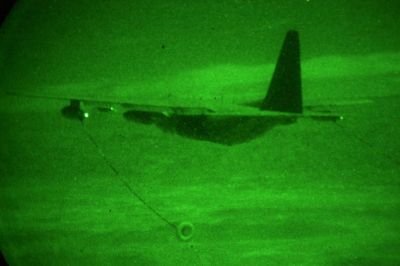
| OPERATION ENDURING FREEDOM (AFIE) -- An MC-130E Combat Talon I awaits the arrival of two MH-53J Pave Low III helicopters for a nighttime aerial refueling mission in support of Operation Enduring Freedom. The MC-130 provides infiltration, exfiltration and resupply of special operations forces and equipment in hostile territory. Its secondary missions include psychological operations and helicopter air refueling. (U.S. Air Force photo by Tech. Sgt. Scott Reed) (VIRIN: 011205-F-4884R-010) (Dec 2001)
Operation Southern Watch, Saudi Arabia (Aug 1992 - 2003) According to Special Operations.com, the 8th SOS was deployed on Operation Southern Watch. In 1991, Saddam Hussein launched attacks against the southern Shite muslims in his country. The UN applied sanctions and initiated a no-fly zone. At first Iraq complied, but in 1992 it started to challenge the UN mandate by moving radar-controlled SAM sites in the no-fly zone. Southern Watch was basically quiet until 1994 when the U.S. forces began to drawdown and return to the U.S. Following an additional Iraqi confrontation in September 1996 - Operation Desert Strike - a buildup started again in the Gulf. Over 6,000 Air Force personnel were deployed in support of the coalition Operation Southern Watch air operation over southern Iraq with the USAF flying 68 percent of the total sorties. The June 1996 bombing of the Khobar Towers in Saudi Arabia accelerated Air Force efforts to protect its forces operating around the globe. In February 1998, the 8th SOS was directed to Saudi Arabia as a buildup in the Iraq tensions increased. The MC-130s returned to Saudi Arabia during the buildup of U.S. forces to convince Iraq to comply with U.N. weapons inspections. (See Recent U.S. Action for day-by-day synopsis events of buildup leading to the Iraq War.)
On 13 November 1998, President Clinton ordered air attacks on Iraq but canceled the order the following morning, as planes were in the air, following an Iraqi promise the UN weapons inspectors could resume work. Between 16-19 December 1998, following an UNSCOM report detailing continued Iraqi obstruction, the US and Great Britain conducted a four-day aerial bombing campaign, nicknamed Desert Fox. France immediately withdrew from the coalition after the Desert Fox. In December 1998 SA-6 SAM sites were bombed after firing upon F-16 aircraft. (For details on Operation Southern Watch go to FAS: Southern Watch.)
Southern Watch continued with intermittent violations. In 1999, the MiG-24 Iraqi jets violated the no-fly zone and were fired at by F-16 and F-15 aircraft with air-to-air missiles. The attempts failed to shoot down the aircraft. At that time there were a total of 70 violations. By May 2000, the violations climbed to 470 with surface-to-air missile and AAA fire directed against coalition pilots. Iraqi aircraft had violated the no-fly zone more than 150 times. In Jan 2001, Operation Southern Watch aircraft struck surface-to-air missile systems in southern Iraq along with AAA sites. At that time more than 670 separate incidents of Iraqi surface-to-air missile and anti-aircraft artillery fire directed against coalition pilots since December 1998.
In addition there were on-going efforts in Operation North Watch to enforce a no-fly zone in northern Iraq and Operation Provide Comfort to provide humanitarian assistance to the northern Iraqi Kurd population.
The following is from 16th SOW News Release: 13 February 1998 telling about the deployment capabilities of the 16th SOW. The article related how the 8th was deployed to try to convince Saddam Hussein to allow nuclear inspectors into his country and illustrates the capabilities and taskings of the SOW. The aircraft was based in Kuwait, along Iraq's southeast border as Saudi Arabia refused to allow American aircraft based within its borders to be part of an attack on Iraq. When the operations were elevated to Operation Iraqi Freedom, the 8th SOS with its MC-130Es were placed under the 355th Air Expeditionary Group at Masirah AB, Oman. (Specifics on its missions unknown.) Answering the call: Base adds two deployments to busy schedule By Capt. John Paradis
Public Affairs
Hurlburt airmen this week headed for different parts of the globe but for a common purpose: to bolster U.S. military presence.
In addition to Brindisi, Italy and other worldwide commitments, the Air Force Special Operations Command has two additional deployments to add to its scope: Southwest Asia and Korea. Aircraft and airmen from the 8th Special Operations Squadron and the 20th Special Operations Squadron along with enhancements for additional force protection, logistics and combat support capabilities deployed this week to the Middle East.
Included in the deployment were 8th SOS MC-130E Combat Talon I aircraft and 20th SOS MH-53J Pave Low III helicopters.
Earlier this month, two AC-130H Spectre gunships left for the Pacific theater. The 16th SOS gunships arrived in South Korea to augment U.S. military presence there during the deployment of the aircraft carrier USS Independence from the western Pacific to the Persian Gulf.
The two deployments add to the capabilities of forces in the U.S. Central Command and U.S. Pacific Command regions.
The deployments also illustrate the wing's reach around the globe, said Col. Rich Comer, 16SOW wing commander.
"Today, we have people in Brindisi, Italy supporting NATO forces in Bosnia, in Korea supporting the Pacific theater, and the Middle East in support of Central Command," said Comer. "We are a wing with commitments all over the world. That we are in high demand by commanders in numerous theaters is testimony to the professionalism and unceasing hard work of AFSOC airmen and what we provide as special operators."
The 8th and 20th, along with security forces, maintenance, civil engineers and other support people deployed after Defense Secretary William Cohen signed an order Feb. 7 authorizing the deployment of about 50 additional U.S. aircraft to the region.
In addition to 16th Special Operations Wing airmen and aircraft, Air Force Special Operations Command also sent EC-130 Commando Solo aircraft from the 193rd Special Operations Wing, Harrisburg, Pa., to the Gulf region. Elements of AFSOC special tactics also deployed.
Secretary Cohen signed the deployment order in response to Iraqi President Saddam Hussein's continued refusals to allow U.N. weapons inspectors access to all potential weapons-production sites, said the Defense Department.
As of Wednesday, nearly 27,000 American and British troops, hundreds of fighter aircraft, two American carrier battle groups and one British aircraft carrier were assembled in the region, according to DOD.
The United States and Great Britain contends Saddam Hussein must open his doors to U.N. weapons inspectors, said Defense Secretary William Cohen this week. The Iraqi leader must not be allowed to develop or deliver weapons of mass destruction, he said. "We believe he poses a threat to the stability of the region, that he has the capacity to inflict great harm, and has shown no hesitancy to do that in the past," he said.
The United States and Great Britain are not alone, Cohen added. During the week of his travels, first Germany, then Canada and Australia announced their support.
"There is a growing recognition that the U.N. resolutions cannot be flouted if they are to maintain their integrity and credibility," Cohen said.
"We hope diplomacy will succeed,but if it doesn't, then we must compensate and try to reduce his capacity to build and deliver these weapons of mass destruction by military means, if all else fails."
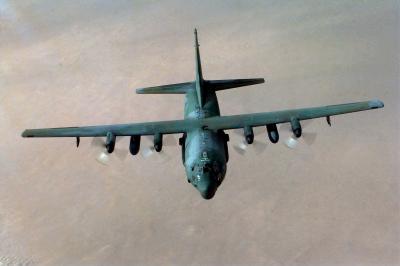
MC-130HThe following article appeared in the Northwest Florida Daily News on 10 Feb 1998. Troops ordered to Kuwait; Hurlburt forces readied Airmen from the 8thand 20th Special Operations squadrons are heading for the Persian Gulf.
by BRUCE ROLFSEN Daily News Staff Writer
HURLBURT FIELD -- Aircraft and crews from this special operations base have been ordered to the Persian Gulf, Hurlburt Field spokesmen said Monday.
Being dispatched from Hurlburt Field are MC-130E Combat Talon I airplanes of the 8th Special Operations Squadron and MH-53J Pave Low helicopters of the 20th Special Operations Squadron. How many airmen and aircraft are being sent and when they are leaving aren't being discussed.
"We can't talk about the numbers and the timeline," said Lt. Darren Berry, a spokesman for the Air Force Special Operations Command headquarters at Hurlburt.
In addition to crews from the 8th and 20th, Hurlburt will be sending support teams for security, maintenance and supplies, Berry said.
Both squadrons fought in Desert Storm during 1991 and since then have frequently rotated aircraft and crews to Saudi Arabia and the Persian Gulf region for temporary deployments.
When the current dispute with Iraq began growing in November, the 20th and 8th didn't have teams in the region. For more than a week, some Hurlburt air crews and support units have been on notice that they could be called for duty in the Persian Gulf.
The Combat Talons can fly directly to the Persian Gulf, using in-air refueling or landing at bases to take on more fuel.
While Pave Lows can also be refueled in the air, for cross-Atlantic flights the helicopters are usually carried inside jet transports, such as the C-5 Galaxy or C-17 Globemaster.
Official word of the deployment didn't come until this past weekend when Secretary of Defense William Cohen, while in Europe, approved American generals's request for 50 more aircraft.
Most of the new aircraft are expected to be based in Kuwait, along Iraq's southeast border. Saudi Arabia, where many of the Air Force's planes and helicopters are located, has refused to allow American aircraft based within its borders to be part of an attack on Iraq.
During Desert Storm, Pave Lows were used to infiltrate Iraqi territory at night. At the start of the 1991 air war, two Pave Lows led Army attack helicopters for a rocket assault on front-line Iraqi radars. Pave Lows were also used to fly in Army special force reconnaissance teams and rescue air crews shot down behind Iraqi lines.
The Talons can be used to refuel the Pave Lows and other helicopters or sneak behind enemy lines to deliver ground forces, vehicles and supplies.
One third of all airdrops in the first three weeks of Desert Storm were flown by Talons.
The Talons can also be rigged to let loose one of the Air Force's largest bombs, the BLU-82, roughly the size of a Volkswagen Beetle and weighing about 15,000 pounds, or to release propaganda and warning leaflets.
Also bound for the gulf are aircraft from the 193rd Special Operations Wing in Pennsylvania, Berry said.
The Air Force Reserve outfit flies EC-130E Commando Solos -- C-130s that have been turned into flying radio and television transmitters. From their high vantage point the Solos can broadcast programs directly to Iraqis or jam some Iraqi signals.
Already in the Persian Gulf from Northwest Florida are about 200 airmen and a dozen F-15 Eagle fighters from Eglin's 33rd Fighter Wing. Since late November the wing has been flying missions over Iraq from a base in the island nation of Bahrain.
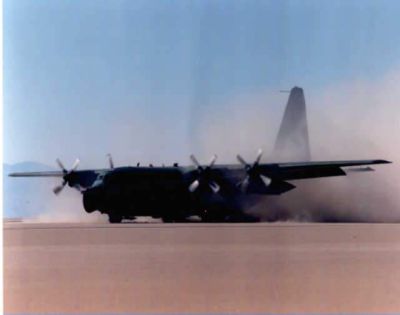
Talon I from the 8th SOS on the ground
( Vic Everett)
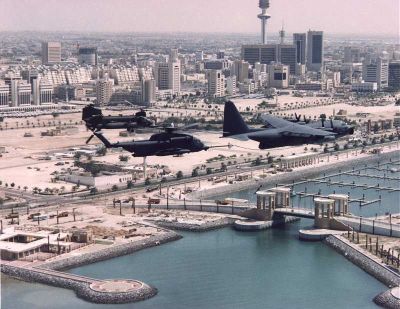
Talon I from the 8th SOS refueling two helicopters over Kuwait City
( Dan Moore )
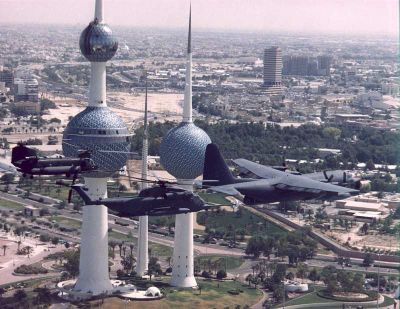
Talon I from the 8th SOS refueling two helicopters over Kuwait City
( Dan Moore ) Operation Iraqi Freedom (2003) At 9:34 PM EST on March 19, 2003 (5:34 AM local time in Baghdad on March 20), United States and United Kingdom forces consisting of 40 cruise missiles and strikes led by 2 F-117s from the 8th Fighter Squadron (supported by Navy EA-6B Prowlers) and other aircraft began conducting military operations against the state of Iraq designed to disarm Iraq of its weapons of mass destruction and to remove the Iraqi Regime from power. (Go to Global Security.org: Iraqi Freedom for details on Operation Iraqi Freedom.) After less than 30 days, the Iraqi government crumbled.
The 8th SOS aircraft were based outside of Saudi Arabia in Oman as Saudi Arabia refused to allow American aircraft based within its borders to be part of an attack on Iraq. When the operations were elevated to Operation Iraqi Freedom, the 8th SOS with its MC-130Es were placed under the 355th Air Expeditionary Group at Masirah AB, Oman. MC-130s Fly Northern Watch Missions. (Specifics on its missions unknown at this time.)
According to Global Security.org: Iraqi Freedom, "Operation Iraqi Freedom consisted of the largest special operations force since the Vietnam War. While the vast majority of special operations forces were American, the United Kingdom and the Australian militaries also provided forces. In northern Iraq there was a significant special operations presence. Coalition personnel worked with Kurdish fighters against the regime. SOF helped bring in the 173rd Airborne Brigade, and marked and called in coalition air power on regime targets. Special operations forces were also responsible for attacking a number of specific targets such as airfields, weapons of mass destruction sites, and command and control headquarters. In the south, special operations personnel gave aid to conventional forces and did some of the work in the cities to help the Shi'ia elements."
(See Recent U.S. Action for day-by-day synopsis events of buildup and Iraq War.) (See Ramza Report for detailed day-by-day information of Iraq War.)
For historical information on dates of assignments, see AFHRA: 8th SOS for details. Participated in Iranian hostage rescue attempt, Apr 1980. Combat in Grenada, 24 Oct–3 Nov 1983; Panama, 20 Dec 1989–14 Jan 1990; Southwest Asia, 16 Jan–17 Mar 1991.
Combat Talon I/IIMC-130E/H COMBAT TALON
These aircraft are equipped with in-flight refueling equipment, terrain-following, terrain- avoidance radar, an inertial and GPS navigation system, and a high-speed aerial delivery system. Some MC-130Es are also equipped with the surface-to-air Fulton recovery and helicopter air refueling systems.
According to the FAS: SOF under the 16th SOW, The 8th SOS and 15th SOS employ the MC-130E Combat Talon I and MC-130H Combat Talon II aircraft, respectively, supporting unconventional warfare missions and special operations forces. The MC-130 aircrews work closely with Army and Navy Special Operations Forces. Modifications to the MC-130 allow aircrews to perform clandestine missions minimizing the chances of being detected by hostile radar systems. Both units’ primary missions are day and night, adverse weather, infiltration, exfiltration, and resupply of special operations forces in hostile or denied territory. In addition, the MC-130E Combat Talon I is capable of clandestine penetration of hostile or denied territory to provide aerial refueling of special operations helicopters.
According to Military Fact Sheet: MC-130E/H and from FAS Org: SOF Reference: Features
Both aircraft feature terrain-following and terrain-avoidance radars capable of operations as low as 250 feet in adverse weather conditions. Structural changes to a basic C-130 include the addition of an in-flight refueling receptacle, and strengthening of the tail to allow high speed/low-signature airdrop. Their navigation suites include dual ring-laser gyros, mission computers and integrated global positioning system. They can locate, and either land or airdrop on small, unmarked zones with pinpoint accuracy day or night.
An extensive electronic warfare suite enables the aircrew to detect and avoid potential threats. If engaged, the system will protect the aircraft from both radar and infrared-guided threats. Currently, the MC-130E is equipped with aerial refueling pods to provide in-flight refueling of Special Operations Forces and combat search and rescue helicopters. The MC-130H will be modified to provide this capability in the near future.
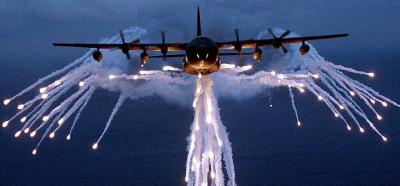
MC-130E Talon I shooting off all flares after Big Safari modification (Lockheed photo)
Combat Talon I (MC-130E) Flown by 8th SOS,16th SOW and 711th SOS, 919th SOW (USAF Reserves)
According to C-130 SPO: Hercules InformationMC-130E/H Combat Talon I and 11
Supporting special operations forces worldwide, AFSOC's CONUS-based 8th SOS and 711th SOS (AFRC) employ 14 C-130Es, modified to MC-130E (Combat Talon I) standard and equipped for use in night/adverse weather, low-level, deep-penetration missions. All are modified to conduct air-to-air refueling with special operations helicopters and have explosion-suppressant fuel tanks and a modified cargo ramp area for high-speed aerial delivery. In addition, these aircraft have been modified to the Mod 90 configuration, which includes an improved APQ-122V(8) terrain-following radar; fully integrated navigation suite with dual INS, Doppler, and GPS: NVG head-up display and new center wing. During Operation Desert Storm the Combat Talon I proved a very adaptable and capable air delivery platform, particularly when called on to deliver the largest conventional weapon in the US arsenal, the 15,000-lb BLU-82. 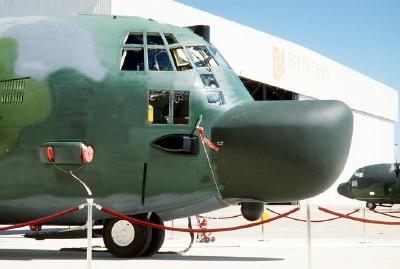
MC-130 Talon NoseAccording to Military Fact Sheet: MC-130E/H and from FAS Org: SOF Reference: The primary difference between the MC-130E and MC-130H involves the degree of integration of the mission computers and avionics suite. The Combat Talon I was conceived originally and developed during the 1960s, and although extensively upgraded in the 1980-90s it still features analog instrumentation and does not fully integrate the sensors and communications suites. The Combat Talon II, designed in the 1980s, features an integrated glass flight deck which improves crew coordination and reduces the crew complement by two.
Mission
The mission of the MC-130E Combat Talon I and MC-130H Combat Talon II is to provide global, day, night, and adverse weather capability to airdrop and airland personnel and equipment in support of US and allied special operations forces. The MC-130 conducts infiltration, exfiltration, resupply, psychological operations, and aerial reconnaissance into hostile or denied territory using airland and/or airdrop. Both Combat Talons are capable of inflight refueling, giving them an extended range limited only by crew endurance and availability of tanker support. The MC-130E Combat Talon I is capable of air refueling helicopters in support of extended helicopter operations. MC-130 missions may be accomplished either single- ship or in concert with other special operations assets in varying multi-aircraft scenarios. Combat Talons are able to airland/airdrop personnel/ equipment on austere, marked and unmarked LZ/DZs, day or night. MC-130 missions may require overt, clandestine or low visibility operations.
Equipment
The special navigation and aerial delivery systems are used to locate small drop zones and deliver people or equipment with greater accuracy and at higher airspeeds than possible with a standard C-130E/H aircraft. The following equipment has been installed on the standard C-130E/
H aircraft to comprise the major components of the MC-130 aircraft configuration:
- · Terrain-Following/Terrain-Avoidance Radar (TF/TA)
- · Precision Ground Mapping Radar (PGM)
- · Precision Navigation System (INS, Doppler and GPS)
- · Automatic Computed Air Release Point System (AUTOCARP)
- · Electronic Countermeasures (ECM)
- · Infrared Countermeasures (IRCM)
- · High Speed Low-Level Aerial Delivery System (HSLLADS)
- · Container Release System (CRS)
- · Ground-to-Air Responder/Interrogator (GAR/I)/MC-130E
- · PPN-19 Beacon/MC-130H
- · Inflight refueling, receiver operations
- · Secure voice HF, UHF, VHF-FM and SATCOM radios
- · Forward Looking Infrared (FLIR)
- · Helicopter refueling operations (MC-130E aircraft only)
- · Internal fuel tanks (Benson tanks)
General Planning Factors
- · MC-130 missions are normally flown at night using a high-low-high altitude profile. The high altitude portion is generally flown prior to penetrating and after exiting the target area. This portion of the flight will be flown at an average ground speed of 260 knots and at an altitude which minimizes fuel consumption and enemy detection. The aircraft will descend to low-level, terrain-following altitudes to penetrate hostile territory. Mission success may require the flight to be conducted at the lowest possible altitude consistent with flying safety, and at a ground speed between 220 and 260 knots. Night vision goggles (NVGs) may be used for night operations.
- · Aircraft range depends upon several factors, including configuration, payload, length of time spent low-level, enroute winds, and weather. For planning purposes, range (without refueling, 2 hours low-level) is 2800nm. Range of the aircraft with inflight refueling is limited only by crew limitations and availability of tanker support. Load capabilities are dependent on aircraft configuration, fuel load, and operating altitude.
- · Mission duration will depend on aircraft basing location, aircraft configuration, crew composition, target location, availability of tanker support, and routing required for successful mission accomplishment.
- · Crew duty day varies for basic crews and augmented crews.
- · The Combat Talon is not a rapid response force. Missions deep into heavily defended enemy territory require extensive preflight planning. Therefore, exercise contingency operations require at least 72 hours prior notification to mission execution.
- · MC-130 aircrews accomplish drops on drop zones with no markings or communications. If commanders agree to use marked drop zones, reception committee personnel must fully coordinate with the aircrew on type markings to be used, configuration of the drop zone, method of authentication and release point determination. The most frequent cause of mission abort is lack of coordination or confusion as to correct marking procedures. Placement and markings types are outlined in AFI 13-217.
- · Not all aircrew members are qualified in all employment events. Also, the aircraft can be configured for several different employment events or combinations of events. Therefore, the employment scenario must be known prior to deployment to determine crew and aircraft mission configuration/equipment requirements.
- · Terrain-following will be degraded during moderate to heavy showers/thunderstorms.
- · Accuracy of airdrops accomplished using onboard navigational equipment (AUTOCARP) is degraded by inaccuracies in DZ coordinates, lack of radar update targets, and a non-operational INS.
The following was excerpted from Skytamer Pics:
The MC-130E flew combat missions during the war in Southeast Asia and took part in the attempted rescue of Americans held at the Son Tay prisoner of war camp in 1970. (SITE NOTE: From 28 August until the end of November 1970, a 13-man 7 SOS crew, commanded by Major Irl L. Franklin, participated in the preparation and execution of the Son Tay Rescue Raid, which was an attempt to liberate POWs held in North Vietnam. Flying Combat Talon 64-0523 (assigned to the 15 SOS at Nha Trang AB, Vietnam), the 7 SOS crew lead a dissimilar formation of H-53s and an H-3 deep into North Vietnam. Although no prisoners were found at Son Tay, the Combat Talon portion of the operation went off without a hitch. All aircraft and crews returned safely to Thailand after the mission.) In 1983, MC-130E's participated in Operation Urgent Fury to rescue Americans from the island nation of Grenada. One of the Combat Talon crews earned the Mackay Trophy for the most meritorious flight of the year by delivering Army Rangers to Point Salines Airfield amidst a barrage of anti-aircraft fire.
In 1989, the MC-130E participated in Operation Just Cause in Panama, helping to seize the airfield at Rio Hato. During Desert Storm the MC-130E's primary role was psychological operations as it airdropped 11 BLU-82/B general purpose bombs and flew multiple missions air dropping and dispersing leaflets. Its secondary role was combat search and rescue.
In 1994, the MC-130E deployed to Haiti with other Air Force Special Operations Command aircraft during operations Restore Democracy and Uphold Democracy. The MC-130H evacuated Americans from the U.S. Embassy in Liberia in 1996. In 1997, the MC-130H participated in Operation Guardian Retrieval, helping to evacuate Americans from the U.S. Embassy in Zaire. Later that year the MC-130H was part of the special operations forces called on for possible support in Cambodia.
The Talon I provided combat search and rescue and special operations forces support for Operation Southern Watch in Iraq in 1997. In September 1997, the MC-130H participated in the search for a C-141 that collided with another aircraft off the coast of Angola. The aircraft also evacuated noncombatant Americans from the Republic of the Congo in 1997. The mission earned the aircrew the Mackay Trophy.
In 1998, the MC-130s returned to Saudi Arabia during the buildup of U.S. forces to convince Iraq to comply with U.N. weapons inspections.
In March 1999, AFSOC Nightflyer News reported, "At Duke Field, the program brings the Reserve's 711th SOS and the 8th SOS together to operate 10 primary, two trainer and two backup MC-130E Combat Talons. The 8th SOS will relocate from Hurlburt to Duke Field. An active-duty maintenance squadron will standup at Duke to jointly maintain the Talons with the Reserve's 919th Maintenance Squadron. In an active associate unit, the Reserves own the aircraft."
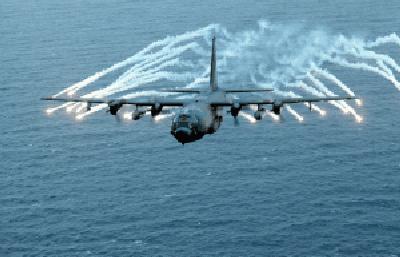
MC-130EMC-130E The MC-130E also has a deep penetrating helicopter refueling role during special operations missions. These aircraft are equipped with in-flight refueling equipment, terrain-following, terrain-avoidance radar, an inertial and global positioning satellite navigation system, and a high-speed aerial delivery system. The special navigation and aerial delivery systems are used to locate small drop zones and deliver people or equipment with greater accuracy and at higher speeds than possible with a standard C-130. The aircraft is able to penetrate hostile airspace at low altitudes and crews are specially trained in night and adverse weather operations.
- Manufacturer: Lockheed-Georgia Company
Marietta, Georgia - Crew: Officers - two pilots, two navigators and an electronic warfare officer; enlisted - flight engineer, radio operator and two loadmasters
- Date Deployed: 1966;
- Inventory: Active force, 0; Reserve, 14; ANG, 0
- Unit Cost: MC-130E, $75 million;
- Dimensions
Wingspan: 132 feet, 7 inches (40.4 meters)
Length: 100 feet, 10 inches (30.7 meters)
Height: 38 feet, 6 inches (11.7 meters) - Wing Area: 1,745 square feet Weights
- Maximum T-O Weight: 155,000-lbs.
- Payload: 53 troops, 26 paratroopers
- Powerplants
No. Engines: Four
Engine Manufacturer: Allison
Engine Designation: T56-A-15 turboprops
Engine Power: 4,910-engine shaft hp each - Performance Speed: 300-mph
- Operational Ceiling: 33,000 feet (10,000 meters)
- Take-off Weight: 155,000 pounds (69,750 kilograms)
- Range: 2,700 nautical miles (4,344 kilometers) Inflight refueling extends this to unlimited range
- Armament Fixed Armament: None

Fulton Ground-to-air rescue System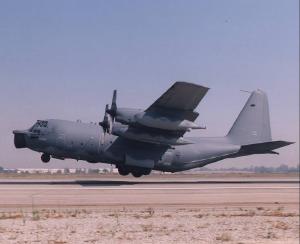
Talon I Tail #0551 flying configured for a Fulton recovery pickup (Lockheed-Martin)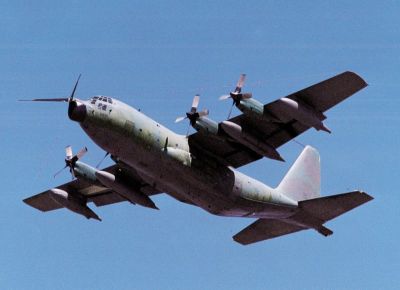
Fulton recovery system ( Unknown)
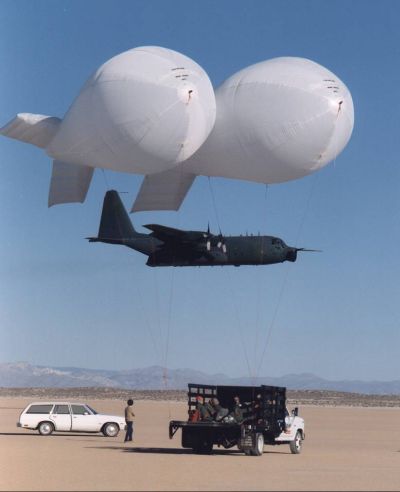
Fulton recovery setup with balloons
( Diana Nittel) (NOTE: According to the Global Security.org "Col. Allison Brooks, then Commander of the ARRS, and A3C Ronald Doll participated in the first human testing of the Fulton surface-to-air two-man recovery kit at Edwards AFB, California in May 1966. Recovery kits were designed for one and two-man recoveries, but eventually proved impractical for most rescue purposes. By 1996 the 8th SOS was the only unit in the world that maintained crew proficiency in the use of the Fulton recovery system, and had been prepared to launch if called upon since the late 1960's. A fatal accident in 1982, the only fatality in 17 years of live pick-ups, damaged the credibility of the personnel pick-up system within the special operations community. That, along with the increased availability of long-range air-refuelable MH-53J Pave Low and MH-47E Chinook helicopters, and tightening budgets, caused AFSOC to deactivate the capability in September 1996." In 1997, the 8th SOS had one of the last remaining Fulton recovery systems.)
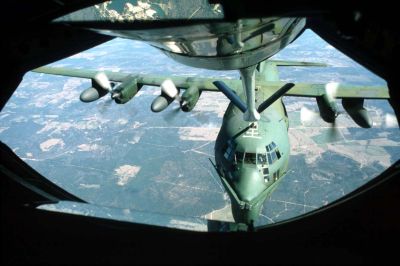 | Sept 1997: The mission of the MC-130E Combat Talon I and MC-130H Combat Talon II is to provide global, day, night and adverse weather capability to airdrop and airland personnel and equipment in support of U.S. and allied special operations forces. The MC-130E also has a deep penetrating helicopter refueling role during special operations missions. These aircraft are equipped with in-flight refueling equipment, terrain-following, terrain-avoidance radar, an inertial and global positioning satellite navigation system, and a high-speed aerial delivery system. The special navigation and aerial delivery systems are used to locate small drop zones and deliver people or equipment with greater accuracy and at higher speeds than possible with a standard C-130. The aircraft is able to penetrate hostile airspace at low altitudes and crews are specially trained in night and adverse weather operations. Nine of the MC-130E's are equipped with surface-to-air Fulton air recovery system, a safe, rapid method of recovering personnel or equipment from either land or water. It involves use of a large, helium-filled balloon used to raise a 450-foot (136.5 meters) nylon lift line. The MC-130E flies towards the lift line at 150 miles per hour (240 kilometers per hour), snags it with scissors-like arms located on the aircraft nose and the person or equipment is lifted off, experiencing less shock than that caused by a parachute opening. Aircrew members then use a hydraulic winch to pull the person or equipment aboard through the open rear cargo door. (USAF Photo) |
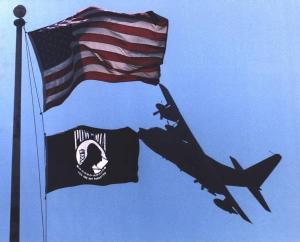
MC-130E flying behind POW flag (Diana Nittel) | 
Talon I (tail # 568) in California after Mod 90 completion (Diana Nittel) | 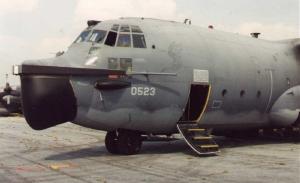
MC-130E 64-0523 at the McDill AFB airshow side view (Dan Moore) | 
MC-130E 64-0523 at the McDill AFB airshow close shot at fornt of aircraft (Dan Moore) | 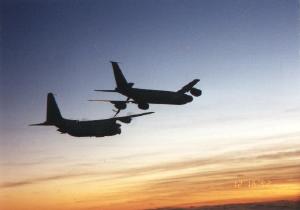
MC-130E 64-0555 being inflt refueled by a KC-135 at sunset Dec 1992 (John Huff) | 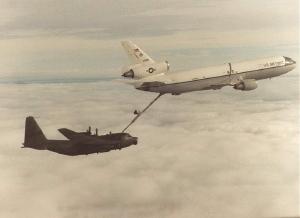
Talon I being refueled inflight by a KC-10. (John Huff) |
Combat Talon II (MC-130H) Flown by 15th SOS, 16th SOW (CONUS)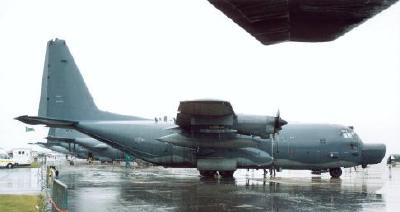
MC-130HAccording to C-130 SPO: Hercules Information Twenty-four MC-130H (Combat Talon II) aircraft have been acquired to supplement the Talon I. Equipment includes an in-flight refueling receptacle;explosion suppressant fuel tanks: modified cargo ramp area for high-speed aerial delivery; AN/APO-1 70 precision turning, terrain-following, and terrain-avoidance radar dual radar altimeters; dual INS; integrated GPS receiver flight stabilized Infrared Detection Set; extensive communications suite; fully integrated glass cockpit; and improved infrared and electronic defensive countermeasures. The 1st, 7th, and 15th SOSs employ the Combat Talon II, supporting unconventional warfare units from their bases in Japan, Europe, and CONUS, respectively. The 58th Special Operations Wing at Kirtland AFB, N. M., is responsible for MC-130H mission qualification training. A direction by Congress in 1981 to upgrade and expand the Combat Talon fleet set in motion the Combat Talon II program. Actual flight testing of the MC-130H began in September 1988. The 1275th Test and Evaluation Squadron was responsible for initial flight testing. The MC-130H arrived at Hurlburt Field in 1991 and was assigned to the 8th SOS. (SITE NOTE: The first of the MC-130H, Combat Talon IIs, arrived on 17 October 1991 and later that year the squadron was split into two sections (Talon I and Talon II).)As of 2000 twenty-four MC-130Hs had been delivered, following an IOC in June 1993, the program achieved FOC in FY 2000. The following is excerpted from Skytamer Pics:
The MC-130H Combat Talon II provides global, day, night and adverse weather capability to infiltrate, resupply and exfiltrate U.S. and allied special operations forces. Features:
The aircraft is equipped with in-flight refueling equipment, terrain-following and terrain-avoidance radar, an inertial and global positioning satellite navigation system, and a high-speed aerial delivery system. The special navigation and aerial delivery systems are used to locate small drop zones and deliver people or equipment with greater accuracy and higher speeds than possible with a standard C-130. The aircraft also can penetrate hostile airspace at low altitudes, and crews are specially trained in night and adverse weather operations.
The Combat Talon II features highly automated controls and displays to reduce crew size and workload. The cockpit and cargo areas are compatible with night vision goggles. The integrated control and display subsystem combines basic aircraft flight, tactical and mission sensor data into a comprehensive set of display formats that assist each operator in performing tasks efficiently.
The pilot and co-pilot displays on the cockpit instrument panel and the navigator/electronic warfare operator console -- on the aft portion of the flight deck -- each have two video displays and a data-entry keyboard. The electronic warfare operator also has a data-entry keyboard and two video displays, one of which is dedicated to electronic warfare data.
The primary pilot and co-pilot display formats include basic flight instrumentation and situational data. The display formats are available with symbology alone or with symbology overlaid with sensor video. The navigator uses radar ground map displays, forward-looking infrared displays, tabular mission management displays and equipment status information. The electronic warfare operator's displays are used for viewing electronic warfare data and to supplement the navigators in certain critical phases. For an indepth coverage on the MC-130H Combat Talon II see Global Security.org for details.
The MC-130H conducts infiltrations into politically denied/sensitive defended areas to resupply or exfiltrate special operations forces and equipment. These missions are conducted in adverse weather at low-level and long range. The MC-130H is supported with organic depots for the aircraft, radar, radome, and mission computer. ...
The MC-130H Combat Talon II deploys over 900 feet of refueling hoses in preparation for covert hot (engines running) refueling operation of two helicopters. Night Vision Goggles (NVGs) are the only means of sight as the rear of the plane is in blacked-out mode. The helicopter pilots hover-taxi their craft to within a few hundred feet of one another and the MC-130 for the refueling operation. Without any overt lighting, bonding the aircraft together and finding the refueling connections is extremely tough. The jet fuel is pumped into the helicopters to provide them with the lifeblood necessary to complete their mission. After the last helicopter leaves the area, personnel begin to break down the equipment and load it back onto the aircraft. ...
The MC-130H features highly automated controls and displays to reduce crew size and work load. The cockpit and cargo areas are compatible with night vision goggles. The integrated control and display subsystem combines basic aircraft flight, tactical and mission sensor data into a comprehensive set of display formats that assists each operator performing tasks. On the one hand, the MC-130H is one of the best missionized aircraft in the world. The pilot puts the cue on the dot and can fly any terrain by following profile programmed by the navigator and the aircraft system. On the other hand, it is a poor instrument aircraft. The tape digital displays make it extremely difficult to fly. ...
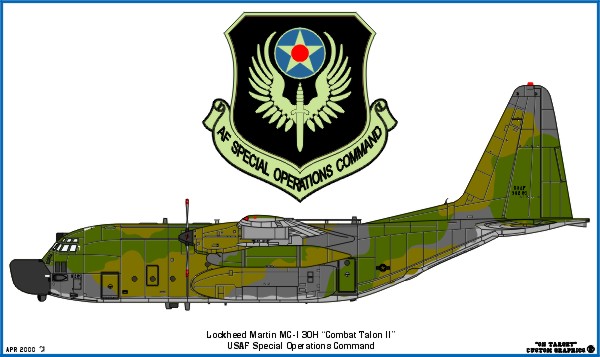 Manufacturer: Lockheed-Georgia Company
Marietta, Georgia Crew: Officers - two pilots, a navigator and electronic warfare officer; enlisted - flight engineer and two loadmasters
Date Deployed: June 1991; Inventory: Active force, 24; Reserve, 0; ANG, 0Unit Cost: MC-130H, $155 million (fiscal 2001 constant dollars)
; Dimensions
Wingspan: 132 feet, 7 inches (40.4 meters)
Length: 99 feet, 9 inches (30.4 meters)
Height: 38 feet, 6 inches (11.7 meters) Wing Area: 1,745 square feet Weights Maximum T-O Weight: 155,000-lbs. Payload: 77 troops, 52 paratroopers or 57 litter patients Powerplants
No. Engines: Four
Engine Manufacturer: Allison
Engine Designation: T56-A-15 turboprops
Engine Power: 4,910-engine shaft hp each Performance Speed: 300-mph Operational Ceiling: 33,000 feet (10,000 meters) Take-off Weight: 155,000 pounds (69,750 kilograms) Range: 2,700 nautical miles (4,344 kilometers) Inflight refueling extends this to unlimited rangeArmament Fixed Armament: None 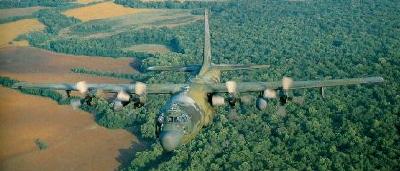
MC-130H According to National Defense Magazine, April 2002, "At least 27 MC-130H Combat Talon II aircraft will receive air refueling capabilities by 2008. According to Gen. Paul Hester, there is a severe "shortage in tanking capability." Currently, he said, "We can only fulfill 35 percent of the requests for air refueling."
The following is from Military.com in Mar 2004: Upgrade is in the air for warplanesThe New technology will fit MC-130Hs with an in-flight refueling system for helicopters.
By MLADEN RUDMAN Daily News Staff Writer
HURLBURT FIELD — Air commandos may want to change their motto from "Any Time, Any Place" to "Any Time, Any Place, More Often" when MC-130H upgrades are finished in about two years.
The Air Force Special Operations Command is expanding the U.S. military’s wartime reach behind enemy lines at night by fitting its 22 Combat Talon II warplanes with an in-flight refueling system for helicopters.
The $197 million MC-130H Air Refueling System — MCARS — program is a joint effort between AFSOC and the Air Force Materiel Command, parent unit of the Air Armament Center on Eglin Air Force Base.
"There is a recognized shortfall in SOF (special operations forces) refueling capabilities," said Maj. Jeff Deans, a Detachment 1, 46th Operations Group flight commander, who runs all of the group’s testing on Hercules transport-based multi-mission MC-130s.
The push to make MC-130 Hs capable of gassing up airborne helicopters is based partially on the intense role commandos from all services have played in the global battle against terrorism.
Helicopters — AFSOC’s MH-53s and the Army’s twin-rotor MH-47s, for example — are used heavily for commando infiltration and exfiltration.
Right now only the Air Force Reserve’s 14 MC-130E Combat Talon I’s have the gear — a hydraulic in-flight helicopter refueling capacity as well as terrain-following and terrain-avoiding radars — to tackle higher-risk penetrations of enemy air space.
Bolstering that specialized fleet by almost two dozen warplanes would translate into a special operations punch for the American military that could be used more frequently.
"It just gives you an extra edge," said Maj. Neicko C. Williams of the AFSOC Headquarters Plans and Programs office.
One drogue
The Combat Talon I and AFSOC’s other air refueler, the MC-130P Combat Shadow, rely on a hydraulic refueling system to feed helicopters jet juice.
To take fuel in flight, a helicopter plugs its telescopic probe into a drogue attached to a retractable hose that trails behind a pod. MC-130 Es and Ps have a refueling pod mounted outboard on each wing.
Currently, drogues come in two varieties — high-speed and low-speed. That refers to how fast an MC-130 can fly to ensure a helicopter connects to the drogue, which is a probe receptacle in the middle of a conical-shaped, louvered basket designed to funnel air.
Though Special Forces helicopters need only low-speed drogues, the Air Force is looking ahead to the day CV-22 tilt-rotors enter its inventory, according to Williams.
CV-22s would refuel at higher speeds, so the Combat Talon II electric refueling system now being tested has an all-purpose drogue that functions at speeds between roughly 115 mph and 230 mph.
In February the refueling system-equipped MC-130H, so far the only one of its kind, passed daytime hookup qualifications for the MH-47 and MH-60 Pave Hawk, a smaller multi-mission helicopter.
The Combat Talon II also has qualified to refuel Air Force MH-53s in daylight.
Data analysis of nighttime refueling qualifications earlier this month with an MH-47 and MH-60 is pending, but Deans said a preliminary review suggested it went well.
The night-flying missions tested lighting on the pod, hose and drogue that helps guide helicopter pilots to a rendezvous. Too bright and the lights could blind a pilot wearing his night-vision goggles.
Other trials
Still ahead for the program are many more tests, including flights at Kirtland Air Force Base, N.M., to determine whether installing the air refueling system affects the way the Combat Talon II performs while using its low-level flight terrain following and terrain-avoiding radars.
The present phase of MCARS testing is designed to uncover and repair problems so the program can take its next step in June. Operational testing will include mimicking the type of flying that would take place in combat.
Lt. Col. Tony Arrington, commander of the 46 th Operations Group at Hurlburt, said testing the air refueling-equipped Combat Talon II is a painstaking process, but the MCARS program is pressing ahead.
"There haven’t been any, what we call, show stoppers," Arrington said.
MISCELLANEOUS RESEARCH INFO:
8th SOS MC-130E S/N: 64-0551; 64-0559; 64-0562; 64-0568 -- All converted to C-130H
7th SOS MC-130E S/N 64-0523; 64-0561 -- All converted C-130H
(Source: C-130 Hercules.)
8th SOS MC-130E S/N 62-1843 and 63-7785 Talon 1
(Source: C-130 HQ Message Board. Joe Baugher Site: 7785 (c/n 382-3852) to MC-130EY. Exploded over the sea off Cam Ranh Bay, South Vietnam Jun 17, 1966 while being operated by VR-7 of US Navy. This serial number was later seen on another aircraft (64-0507) probably used for some sort of black operation. //1843 (c/n 382-3806) modified to MC-130E. Damaged by a satchel charge in South VietNam, repaired. Crashed into hill while on approach to Tuy Hoa, South Vietnam Dec 20, 1965. Later seen operating out of Norton AFB, CA in 1971. This is believed to be another Hercules airframe (64-0506) renumbered for some sort of black operation.)
64-0506/0507 (c/n 382-3990/3991) to Air America in 1964. They were returned to the USAF in 1966. Their trails go cold in 1969. They two planes seem to have been reassigned the serial numbers of a couple of crashed C-130s. Details anyone? 0506 is now flying with SOS 711 as 62-1843, an MC-130E which had crashed in SVN in Dec 20, 1965. 0507 is now flying with SOS 711 as 63-7785, an MC-130E which had crashed in SVN Jun 17, 1966
64-0518 (c/n 382-4002) converted to MC-130E
0523 (c/n 382-4007) converted to MC-130E, then converted to C-130H
0547 (c/n 382-4040) converted to MC-130E. Lost Lai Chau, North Vietnam on classified SOG mission on night of Dec 28/29, 1967. Crew of 11 killed. Site found in 1992.
0551 (c/n 382-4046) converted to MC-130E, then to C-130H
0559 (c/n 382-4062) converted to C-130H
0562 (c/n 382-4068) converted to C-130H
0568 (c/n 382-4086) converted to C-130H
(Source: Joe Baugher site: 64 Serial Numbers.)
News ArticlesFinal Return Home: 1Lt Michael BlassieAs a side note of history, 1st Lt. Michael Blassie, an 8th SOS A-37 Dragonfly pilot, was shot down on May 11, 1972 by North Vietnamese anti-aircraft guns. They sliced apart Blassie's A-37 attack jet while it made a low-level bombing run near An Loc, 60 miles north of Saigon. The story in Air Magazine: Unknown, No More stated, "Maj. James Connally, the flight lead, craned his head back in time to see Blassie nosedive into a thick jungle of rubber trees and watched his wingman's plane explode on impact. "It's a snapshot that will forever be imbedded in my brain," said Connally, now a retired colonel living in Bethesda, Md. "I knew he didn't make it. He was the first and last man I'd ever lose in combat, and I felt deeply responsible. For the past 26 years, I've thought of Michael Blassie often, and I've asked myself what I could've done differently. I have no answers."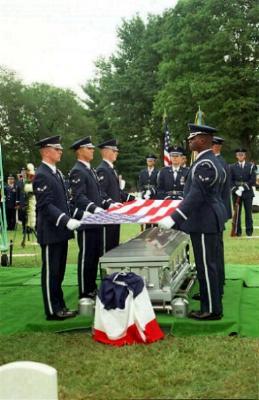
Burial of Lt. Blassie (1998)Although Blassie's remains were recovered later that year, positive identification couldn't be made at the time -- partially due to an administrative SNAFU -- and the remains were reclassified as "unknown." On Memorial Day 1984, Blassie's remains were placed in Arlington National Cemetery's Tomb of the Unknowns. In May 1997, Lt. Blassie's body was disinterred to undergo DNA testing and identified with a "99.9-percent degree of certainty." Lt. Blassie's body was flown home to St. Louis on a MC-130E of the 8th SOS from Hurlburt Field -- Returning one of their own home in July 1998. (Go to Return home for the full story.) 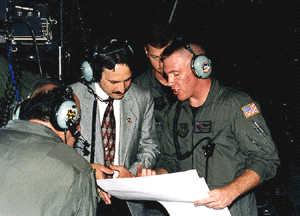
'Blackbirds' bring home one of their own: Senior Airman Pete Ventres, 8th Special Operations Squadron loadmaster, explains his job to George Blassie, 1st Lt. Michael Blassie's younger brother. George was a passenger on the 8th SOS's flight to return his brother's remains to Illinois. (USAF photo)
8th SOS in Movie, "Air Force One" In 1997, the 8th SOS was selected to part of the film "Air Force One" starring Harrison Ford. The reason for its selection was a special retrieval system that was used in the movie. The following 1997 article excerpted from :
8th Special Operations Aircraft flys in 'Air Force One' By 1st Lt. Paul D. Villagran
16th Special Operations Wing Public Affairs
HURLBURT FIELD, Fla. (AFNS)--What do Harrison Ford, Glenn Close and a Combat Talon I have in common?
They will all be seen in "Air Force One," the upcoming movie release scheduled to be in theaters July 25.
Even in Hollywood, where high visibility is critical to achieving success, Air Force special operators worked in virtual darkness for two weeks to film some of the aerial scenes for the movie.
But don't expect to see any Hurlburt Field members on the big screen when the movie is released.
The only thing reflective of Hurlburt Field that may show up in the movie is 559, the tail number of the Combat Talon I filmed during the making of the movie.
"You won't see any faces of our people," said Lt. Col. Jeff Alderfer, 8th Special Operations Squadron director of operations and mission commander during the filming. "All of the interior shots were filmed in a mock model of the inside of the Talon after we were back at Hurlburt Field."
The 8th SOS sent one Combat Talon I with two complete flying crews and a maintenance package from the 8th Aircraft Maintenance Unit to California to participate in the making of the action-thriller last September.
The crews worked odd hours of the night during the filming of the movie which stars Ford as the president who is being held captive by a group of terrorists aboard Air Force One.
"We had a very limited window of opportunity to get the shots the director wanted," said Capt. Mike Montgomery, one of the 8th SOS pilots who participated in the filming. "We would brief the scenes at the hangar prior to going up and practice once we got up in the air. We basically had a 30-minute filming window for light purposes."
Throughout the filming, the Combat Talon crews had to fly a three ship formation with the camera aircraft and the movie-version of Air Force One, a 747 designed to look like the actual presidential aircraft.
The aerial scenes were filmed from the camera aircraft, a converted B-25 bomber nicknamed the "Photo Lady."
While the three-ship formation is similar to flying an aerial refuel mission, the 8th crews were awed at the size of the Air Force One replica flying behind them.
"It looked so close, it felt as if you could reach out and touch it," said Chief Master Sgt. Richard "Taco" Sanchez, 16th Operations Group senior enlisted advisor and one of the loadmasters during the mission.
The 8th crew members were impressed with the amount of time, effort and attention to detail given by the film crews to get one shot.
"The amount of stuff they go through to film one scene is awesome to watch," Sanchez said.
The 8th SOS was selected to participate in the making of Air Force One because they are the only unit in the world with the Fulton Recovery System capability. The Fulton system is designed to intercept a lift line attached to a helium-filled balloon on one end and the retrievable package on the other with a yoke mounted on the nose of the aircraft. Once the line is caught, a hydraulic winch retrieves the package onto the back of the cargo ramp.
The Air Force discontinued the Fulton recovery mission last year, citing high costs and increased capabilities of Air Force Special Operations Command rotary wing aircraft.
While the 8th members are unsure what creative license director Wolfgang Peterson will take during final editing of the movie, they were impressed with the film crew's concern for realism.
"Everything we did in the movie was something we could actually do in real life," said Alderfer.
The members of the 8th who participated in the making of Air Force One were tight-lipped about their role in the film. But they did say they were part of the president's rescue attempt from Air Force One during the final scenes of the movie.
"We used the Fulton hydraulic winch in the back plane as part of the rescue scene," Sanchez said.
Beyond that, the crews who participated in the making of Air Force One were true to their AFSOC heritage as the silent warriors and would not reveal any Hollywood secrets.
8th SOS Orphanage in Honduras The following article is from the Northwest Florida Daily News This article can be found on page 1A of the December 23, 1998 Daily News. A squadron of Santas, 94 happy kids
Hurlburt airmen bring back smiles Mitch washed away
By DEVON RAVINE, Daily News Staff Photographer
LaCEIBA, Honduras - Yuni Maldonado, 9, opened her Barbie doll and clothes, then neatly packed her Christmas gifts back into the box on her lap, her face beaming.
At the opposite end of the picnic pavilion, another girl, no more than 3, carried a box nearly as tall as she back to her folding chair, smiling all the way. Outside the pavilion, an impromptu soccer game erupted when a gift-wrapped ball was quickly put to use by a group of young boys.
For the 94 children of the SOS Orphanage in LaCeiba, Christmas came as it has for the past six years, via green flight-suited airmen from Hurlburt Field bearing candy and gifts.
"The only thing these kids get is what we bring them each year," said Capt. Manuel Torres, a hospital administrator with the 919th Special Operations Squadron at Duke Field. Torres was one of the airmen to first discover the Swiss-based SOS orphanage in 1992, while he was on temporary duty with Hurlburt's 8th SOS at Golosan Air Base, near La Ceiba. Torres and squadron commander Col. Ken Poole were drawn to the orphanage by the facility's SOS sign. In military parlance, SOS stands for Special Operations Squadron.
"When we talked to them, we realized they had no support," said Torres. So members of Hurlburt Field's 8th SOS decided to "adopt" the residents of the Honduras SOS orphanage, making the yearly trip south to distribute Christmas cheer.
This year's Operation Christmas Wish mission, organized by the Hurlburt Field's 16Th Special Operations Squadron, collected 20,000 to 25,000 pounds of goods from local business, churches, schools and civic groups. With Honduras still recovering from the devastation caused by Hurricane Mitch, the emphasis this year was on practical goods.
"In the past we've taken more toys and bicycles," said Capt. Mario Smith, who planned the mission. "This year, we've shifted to clothes, food, medical and building supplies."
Volunteers from Hurlburt Field spent about 21/2 weeks boxing the supplies and securing them to five 7-foot by 9-foot pallets in preparation for the four-hour flight to the Caribbean coastal town. Shortly after 8 a.m. Monday, the Air Force C-130 roared off the runway from Hurlburt Field, loaded with supplies and about a dozen airmen who volunteered to play Santa this year.
After arriving at Golosan Air Base around noon, the airmen unloaded the pallets with the help of U.S. Army and Canadian air force personnel stationed there. In lieu of Santa's sleigh, the airmen loaded their bags of goodies onto a large military dump truck - one of the few vehicles around able to cross a nearby river where a bridge between the air base and the orphanage was washed out. A Santa-capped Staff Sgt. Shane Rainwater sat atop the boxes, delivering hearty Feliz Navidads! and waving to people as the truck moved through a traffic jam en route to the orphanage.
Inside the orphanage compound, the airmen were greeted by wide eyes and shy smiles as the children gathered to examine the bicycles and other gifts being unloaded. The 94 children sat politely on folding chairs around the pavilion while each one was called by Santa's green-suited helpers to receive his or her Christmas present, which had been purchased by military families from Hurlburt Field.
After passing out bags of candy and visiting with the children, the airmen were off to the air base, their C-130 and a long flight home.
For Staff Sgt. Danny Pagan, it was a gift "just to see the kids smile; just to see their happy faces." It was also a chance for him to reflect on his own Christmas back home.
"We take so much for granted," said Pagan, "and they have so little."
The following article appeared in AFRC News Service from a 919th SOW news release (Release No. 00094 - 06/05/00): Total force team returns from exercise in AfricaDUKE FIELD, Fla. – Against the backdrop of Kenya, a country known for its wild game preserves and scenic beauty, a contingent of 100 airmen from here trained in Natural Fire 2000, a humanitarian and civic assistance exercise.
The month-long joint/combined exercise began May 4 and involved several branches of the U.S. military and the East African Coalition of Kenya, Tanzania, and Uganda. U.S. Central Command, MacDill Air Force Base, Fla., was in charge of the American forces.
MC-130E Combat Talon I aircraft belonging to Air Force Reserve Command's 919th Special Operations Wing along with active-duty people and reservists supported the missions. The total force contingent returned home in late May.
About 25 percent of them were reservists from the 919th SOW, primarily in maintenance career fields. Most of the deployment participants were from two active-duty associate units – the 8th Special Operations Squadron and the 716th Maintenance Squadron.
The active-duty squadrons are collocated with the Reserve wing at Duke Field and share the mission of flying and maintaining the aircraft, but are assigned to the active force’s 16th SOW, Hurlburt Field, Fla.
"This exercise trained us how to respond to a natural disaster and work with the different countries and agencies that normally are involved in getting people help," Lt. Col. Lloyd B. Moon Jr., deployment commander from the 8th SOS. During the exercise, a “natural disaster” occurred and then worsened. As a result, a larger force with more capability responded, and the command responsibility was handed over to a combined/joint task force.
In addition to training staffs on how to work in their assigned roles during a humanitarian civic action, aircrews also received great training benefits, according to Moon. "Our crews got to practice dropping supplies to host nation forces. We conducted static line jumps for a host nation military into a drop zone supporting the humanitarian mission training. We practiced operating in a joint task force to perform high operations-tempo, humanitarian-relief missions from a forward operating base in harsh conditions.
"This is Kenya's rainy season, and there's high mountainous terrain here," said Moon. "We practiced in the conditions we expect to have to work when and if the time comes for us to help in a relief effort."
One of the exercise events supported a Medical Civil Action Program in which local residents received medical treatment. The MEDCAP involved landing medical teams and several tons of equipment into Kilamanjaro, Tanzania. The unit provided the same kind of support for dental and veterinary assistance to residents of Tanzania and Kenya.
"We worked closely with Kenyan, Tanzanian, and Ugandan air force personnel, which helped improve combined operations support humanitarian relief," said Moon.

MC-130E from 8th SOS flying low level in Africa (Dave Shelikoff)
8th SOS Refuel Crews Win Award The following appeared in the 21 May 2002 edition of the Northwestern Florida News. AFSOC crews win top honors Two Duke Field-based, active-duty crews will share the prestigious Brig. Gen. Ross G. Hoyt Award for outstanding air refueling crew of the year.
The 8th Special Operations Squadron crew members received the award for their multiple refuelings of a Special Operations helicopter during a November 2001 rescue mission over the snowy mountains of Afghanistan. The helicopter crew, assigned to Hurlburt Field, received the MacKay Trophy for meritorious flight of the year for the endeavor.
Although housed at Duke, 8th SOS members are attached to Hurlburt's 16th Special Operations Wing.
Citing national security, an Air Force spokeswoman declined to release the names of the MC-130E Combat Talon refueling crews.
Formerly based at Hurlburt, the 8th SOS moved to Duke in February 2000. The move marked the first time an active-duty Air Force Special Operations Command unit provided crews and maintainers for missions flown on Air Force Reserve aircraft.
For inputs or comments, contact Kalani O'Sullivan.NOTICE/DISCLAIMER: The content of this page is unofficial and the views and opinions expressed do not necessarily reflect those of anyone associated with this page or any of those linked from this site. All opinions are those of the writer and are intended for entertainment purposes only. Links to other web pages are provided for convenience and do not, in any way, constitute an endorsement of the linked pages or any commercial or private issues or products presented there.
 You are listening to Sweet Home Alabama You are listening to Sweet Home Alabama
Return to Top | 
28 October 2003 |
For inputs or comments, contact Kalani O'Sullivan.NOTICE/DISCLAIMER: The content of this page is unofficial and the views and opinions expressed do not necessarily reflect those of anyone associated with this page or any of those linked from this site. All opinions are those of the writer and are intended for entertainment purposes only. Links to other web pages are provided for convenience and do not, in any way, constitute an endorsement of the linked pages or any commercial or private issues or products presented there.
Copyright 2003 - All Rights Reserved
email to: kalani@hanvit.com

FastCounter by bCentral
|

